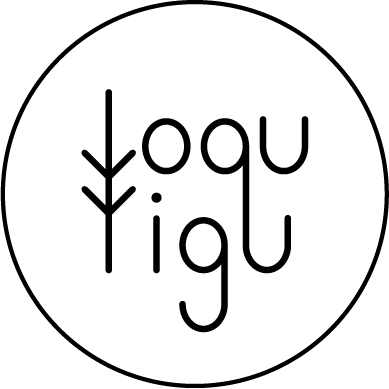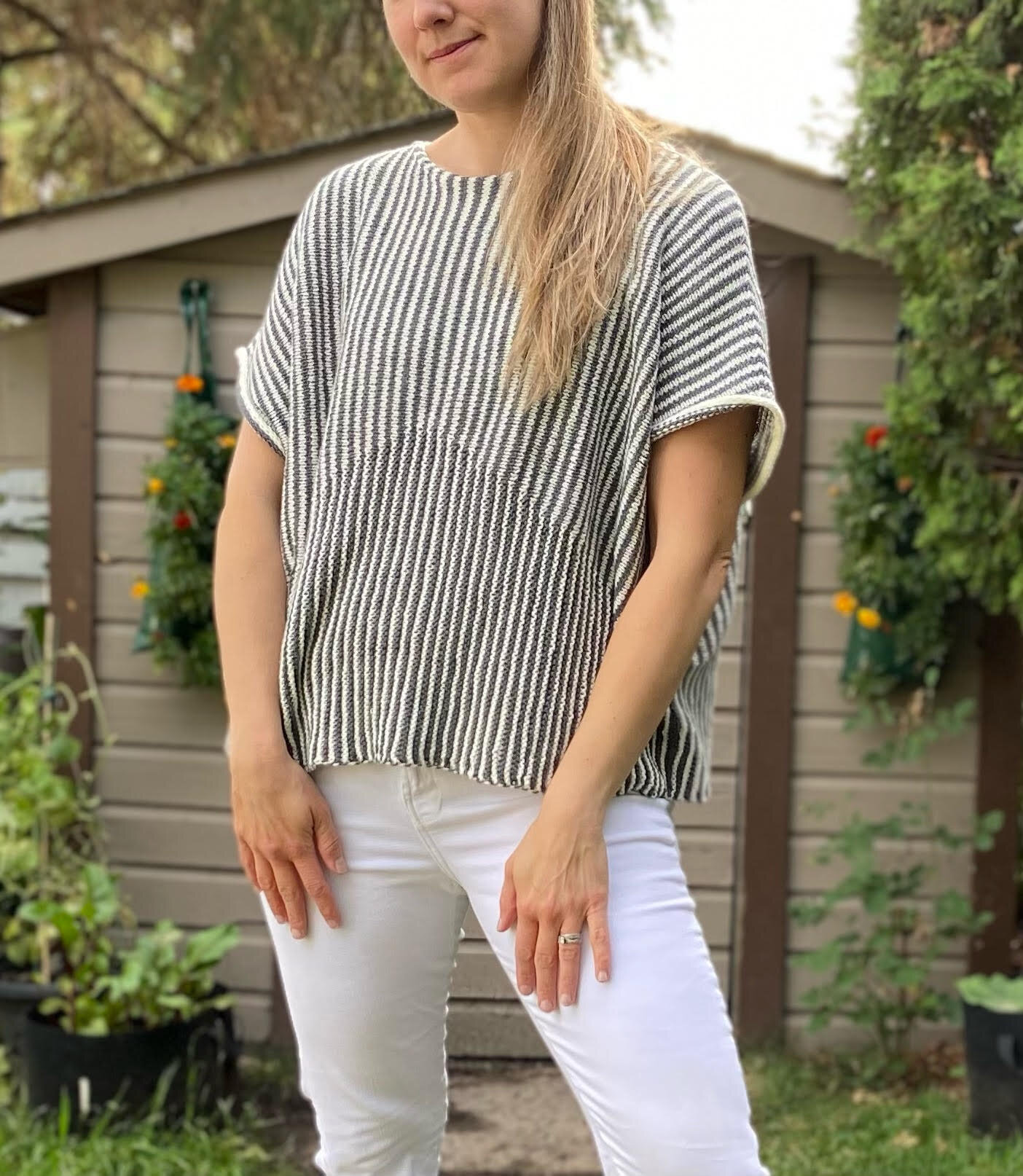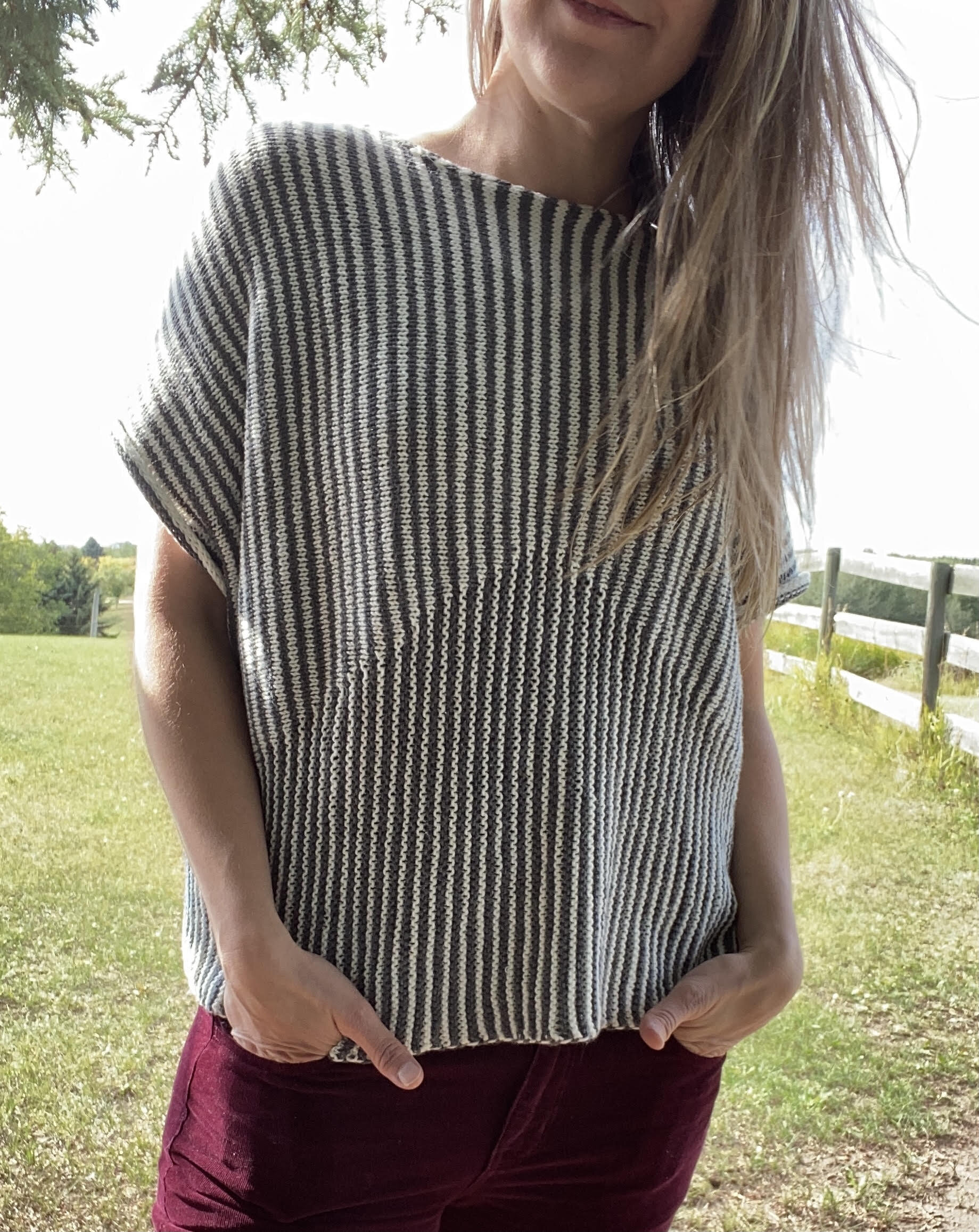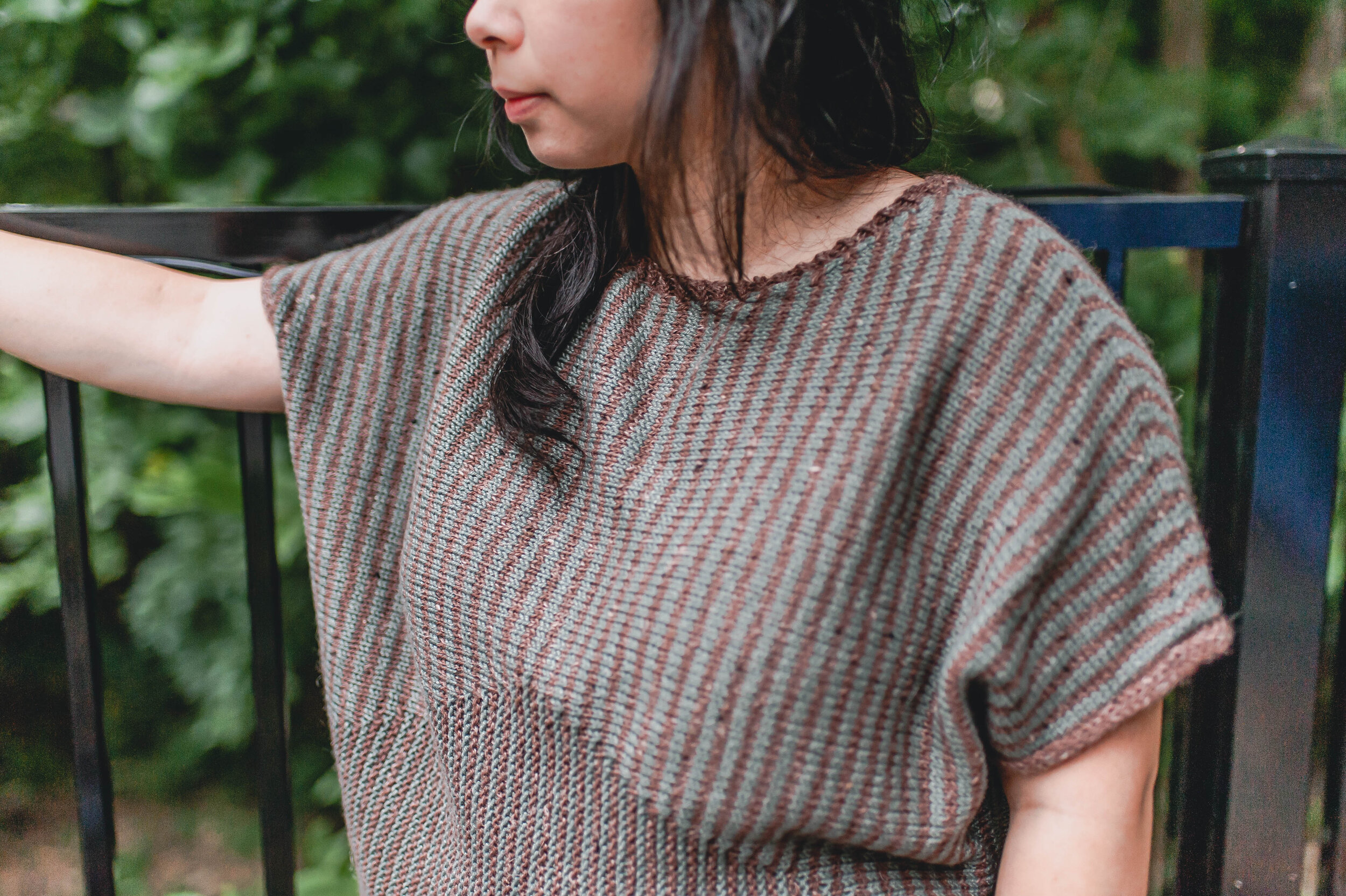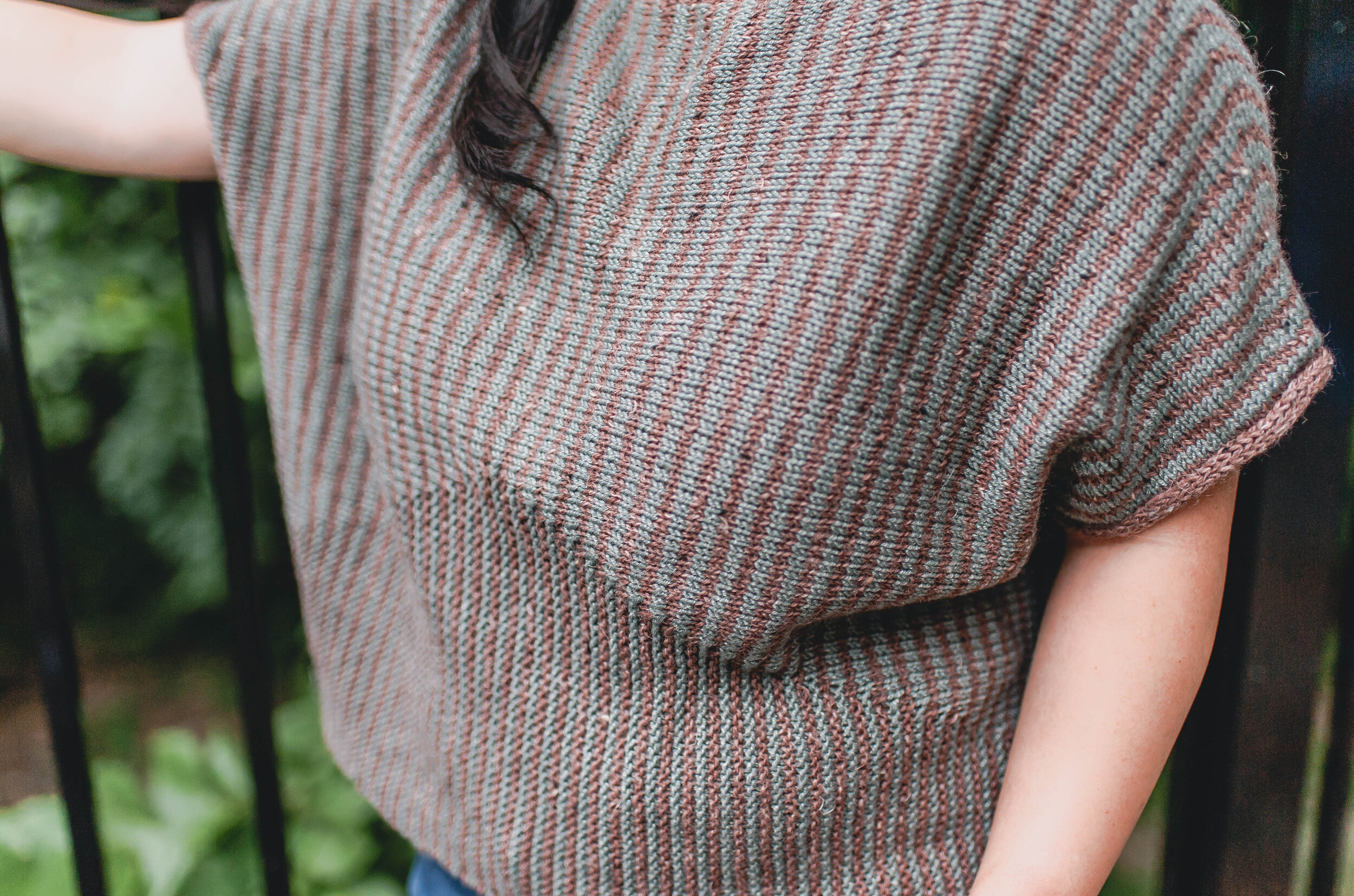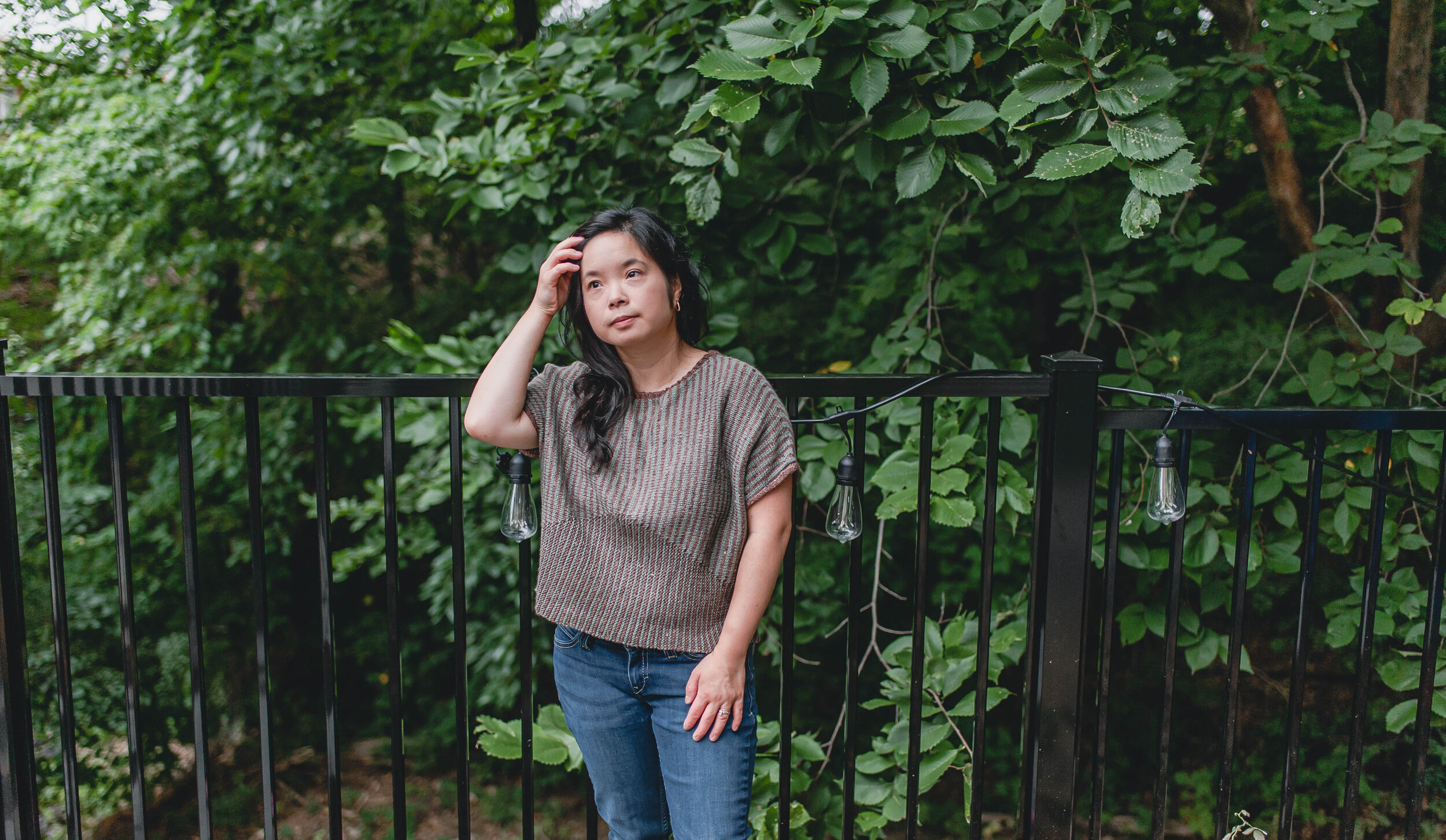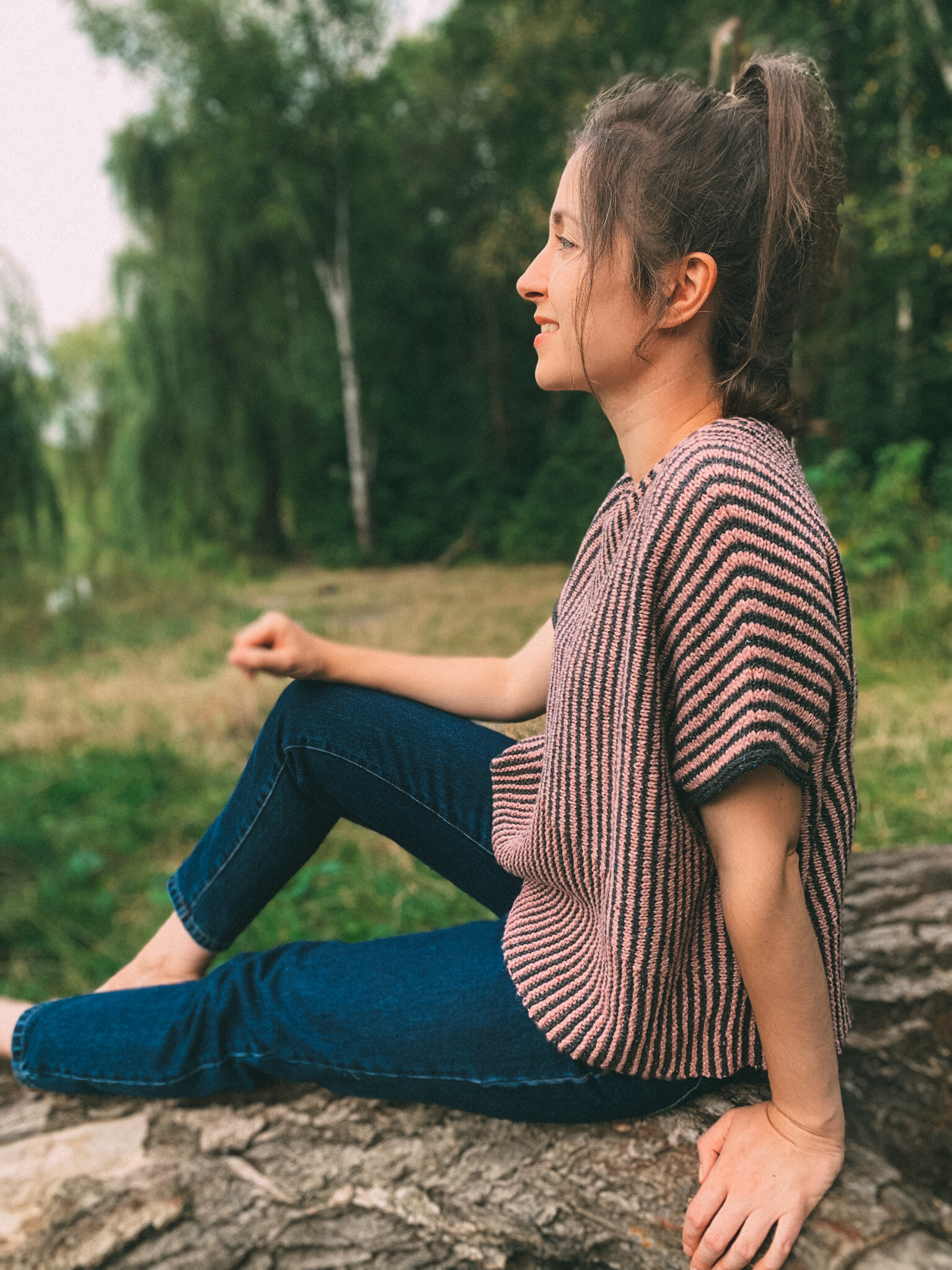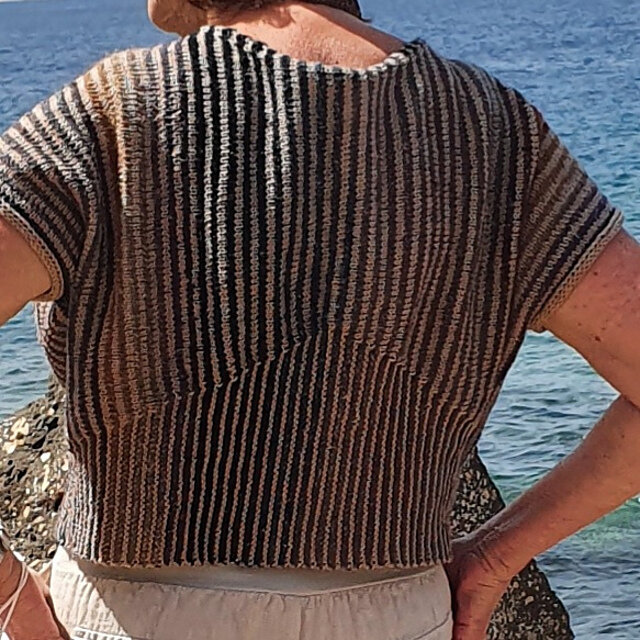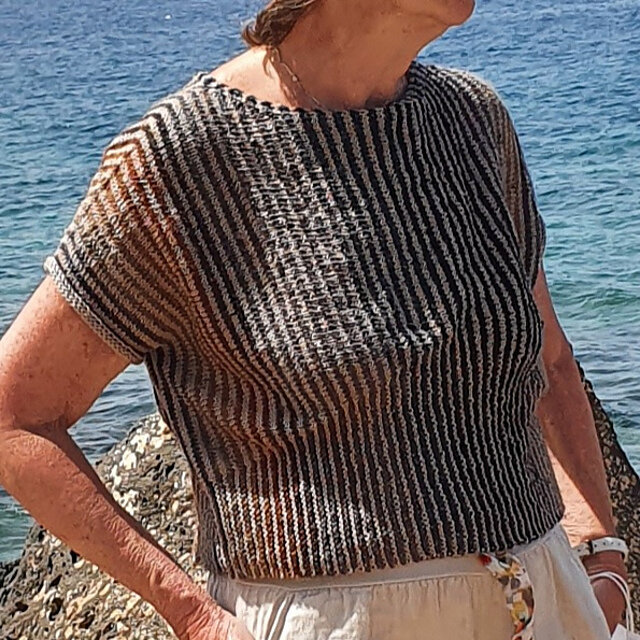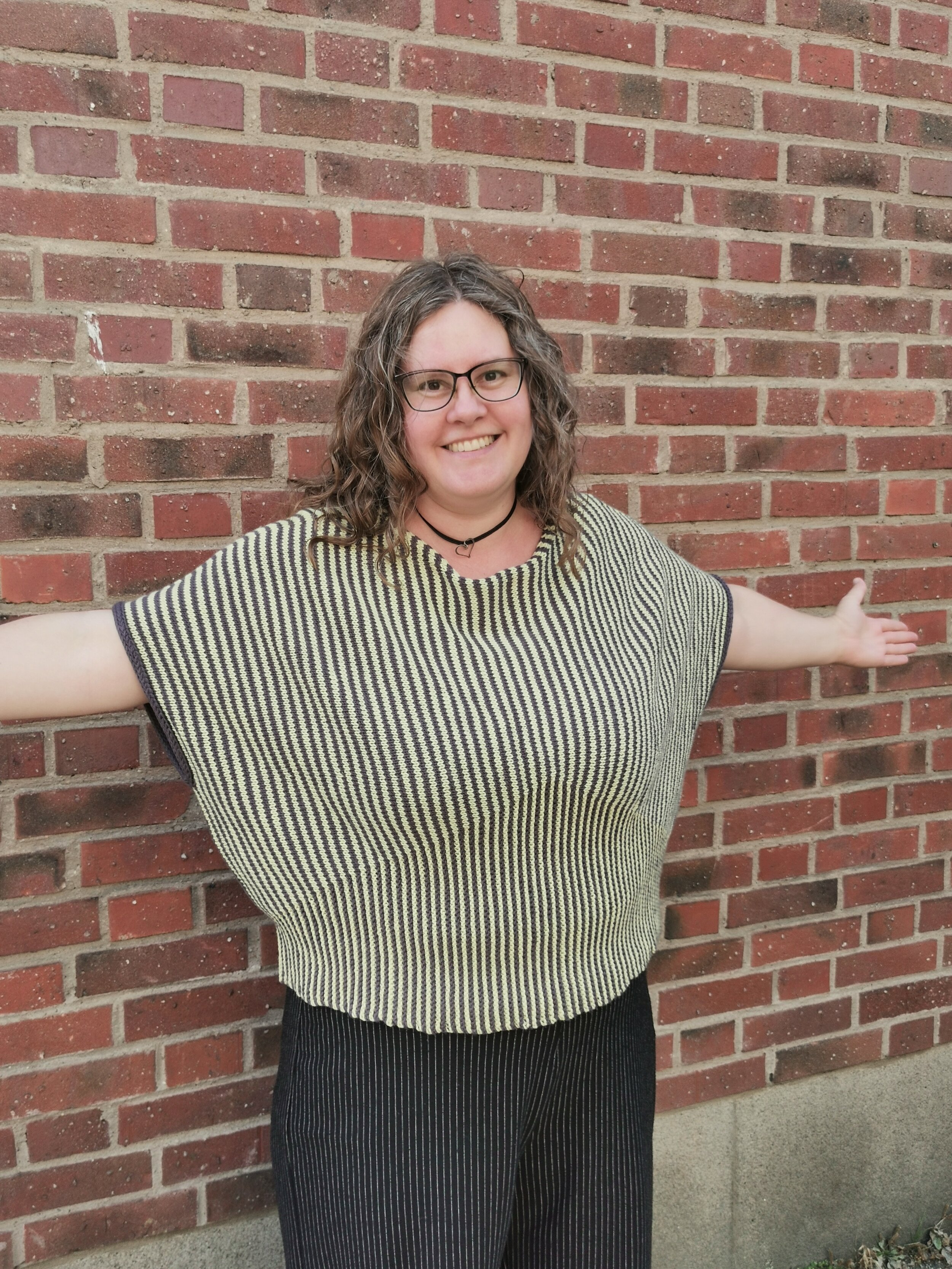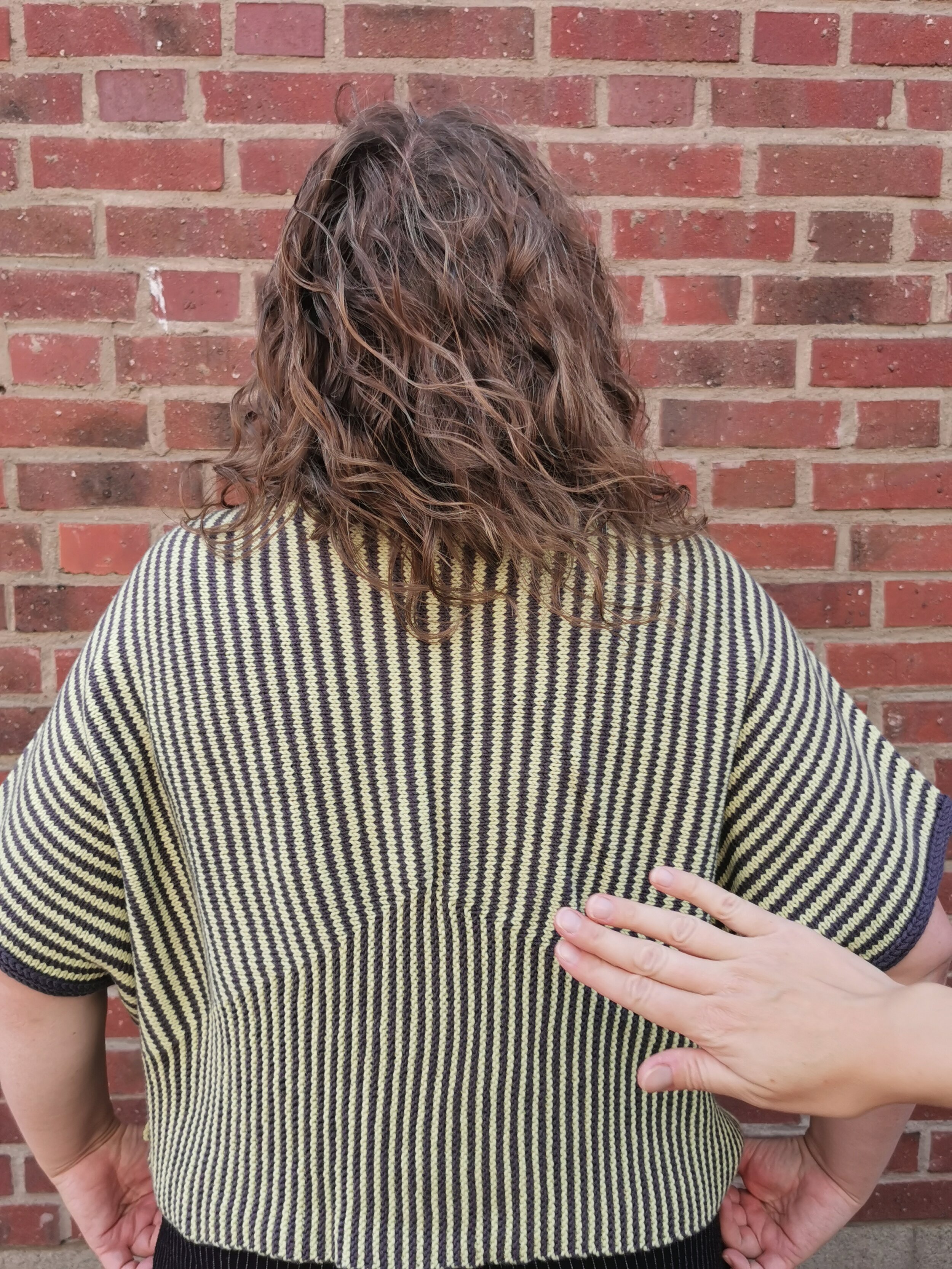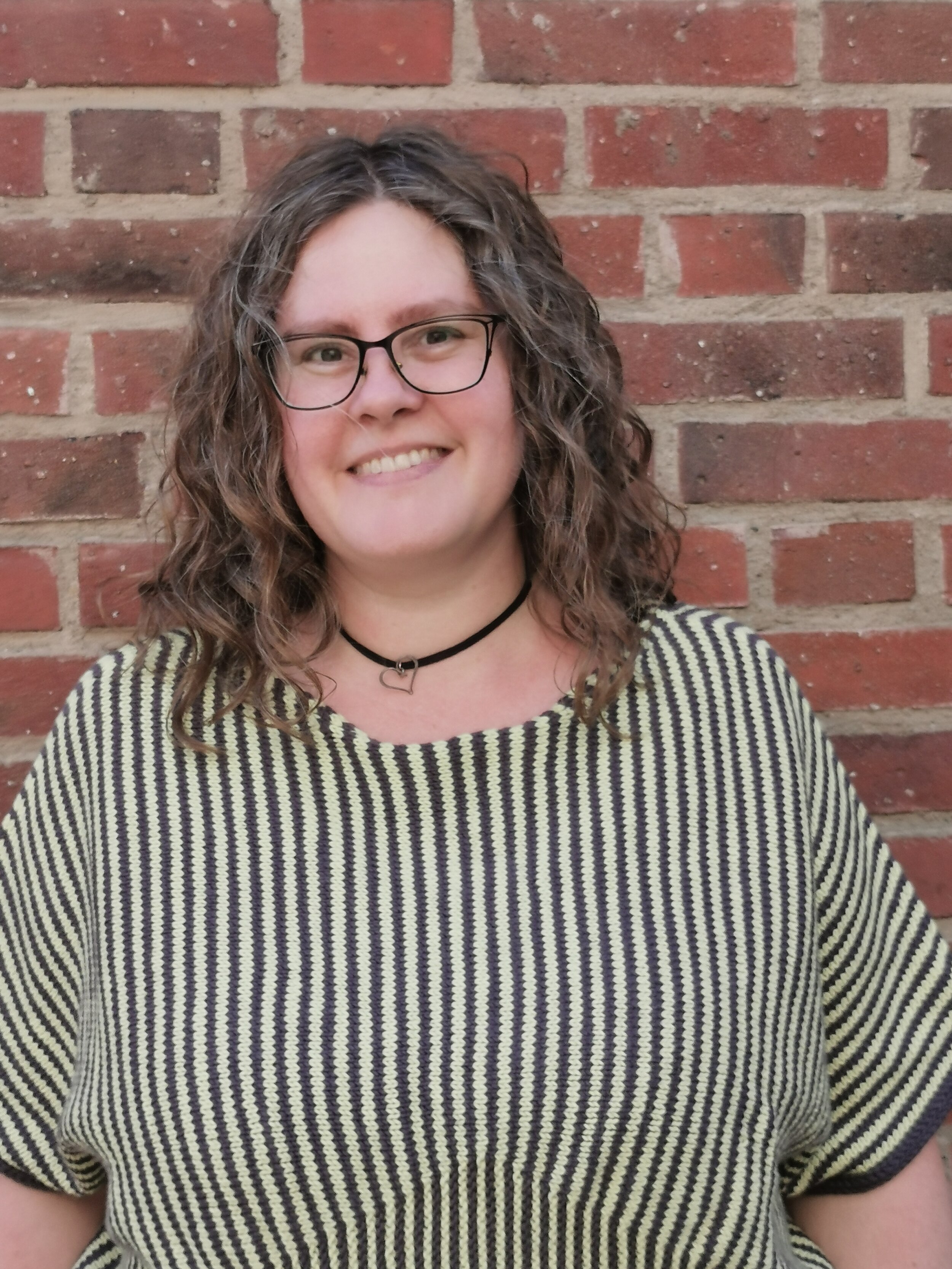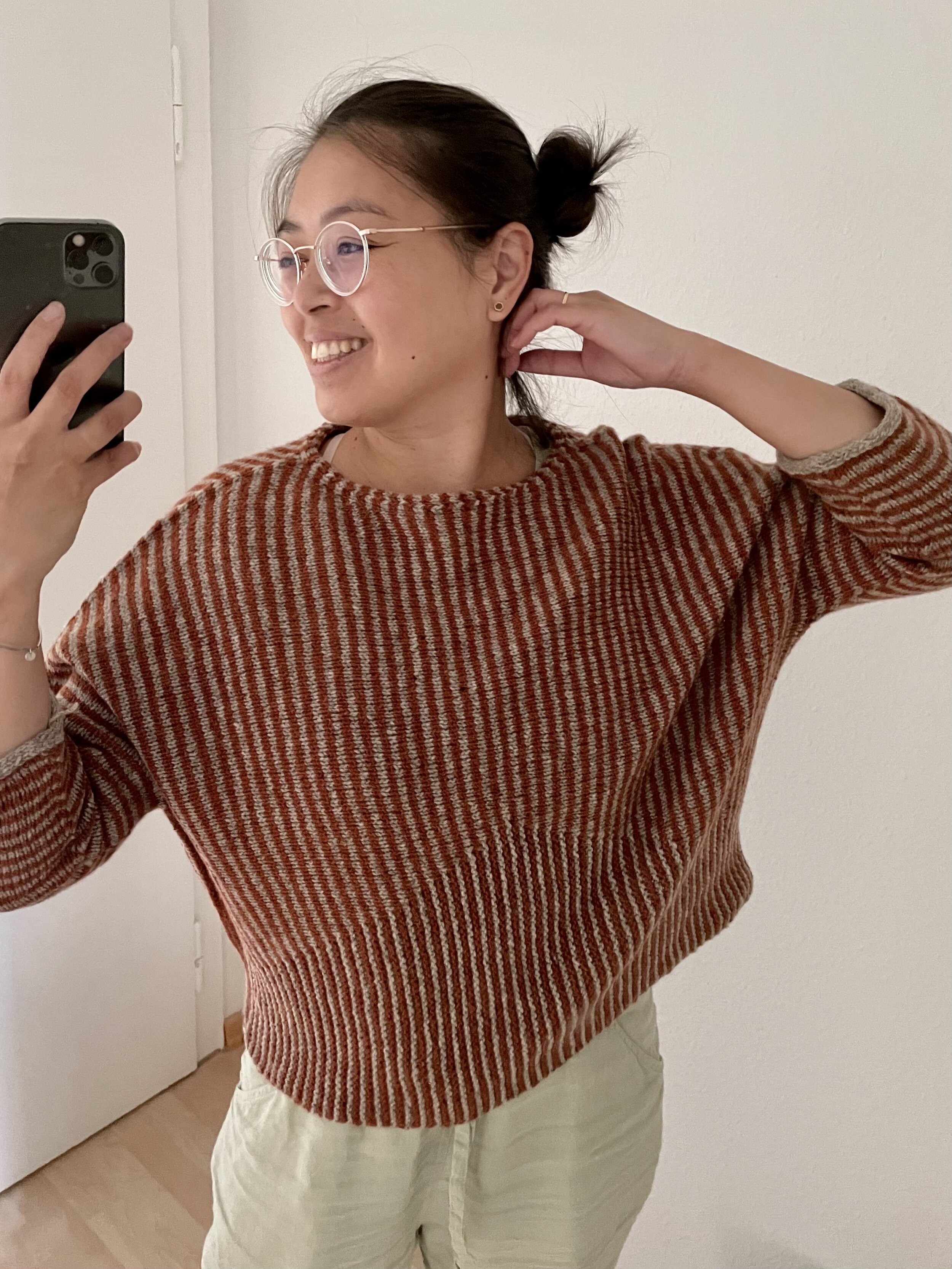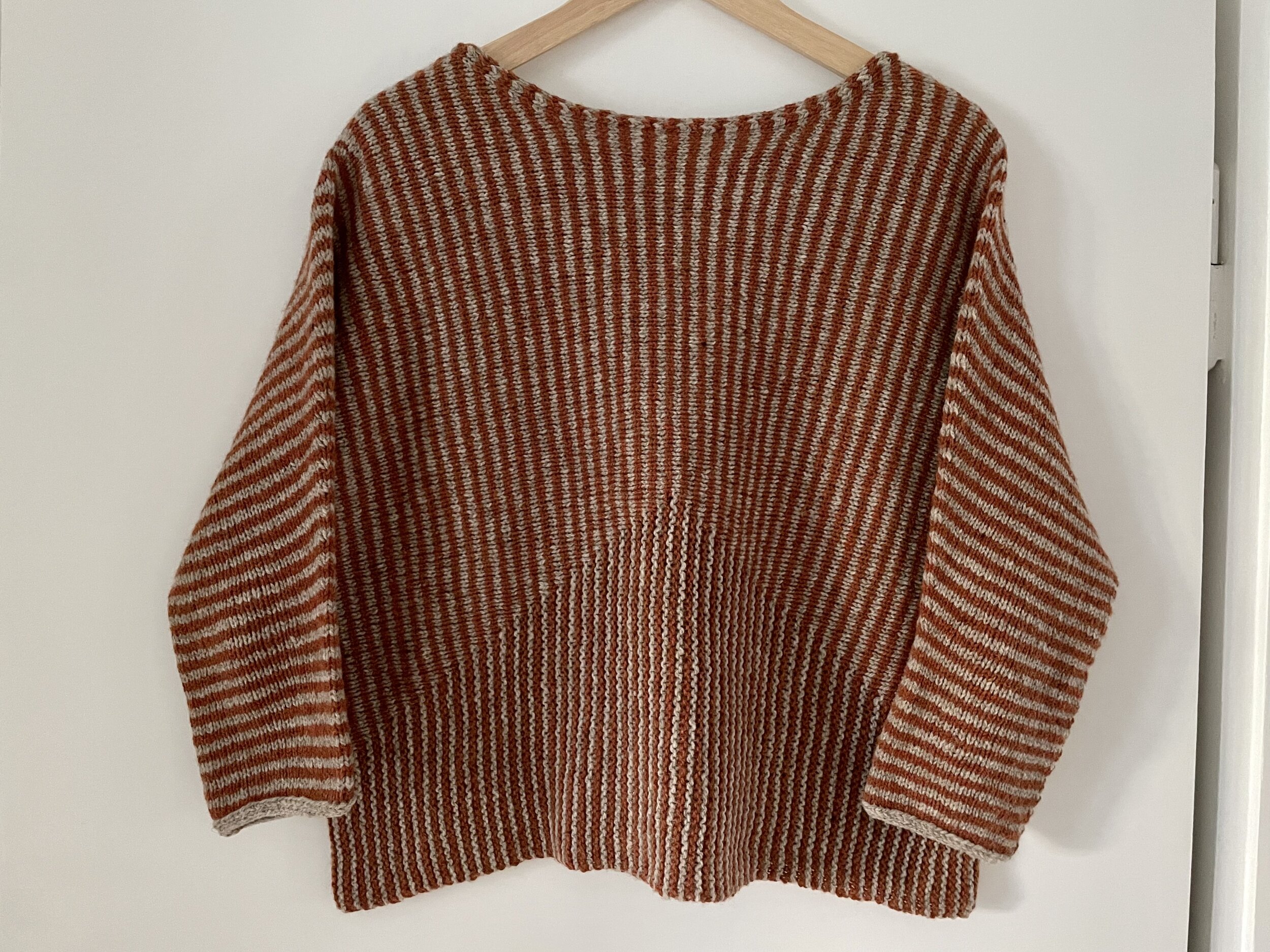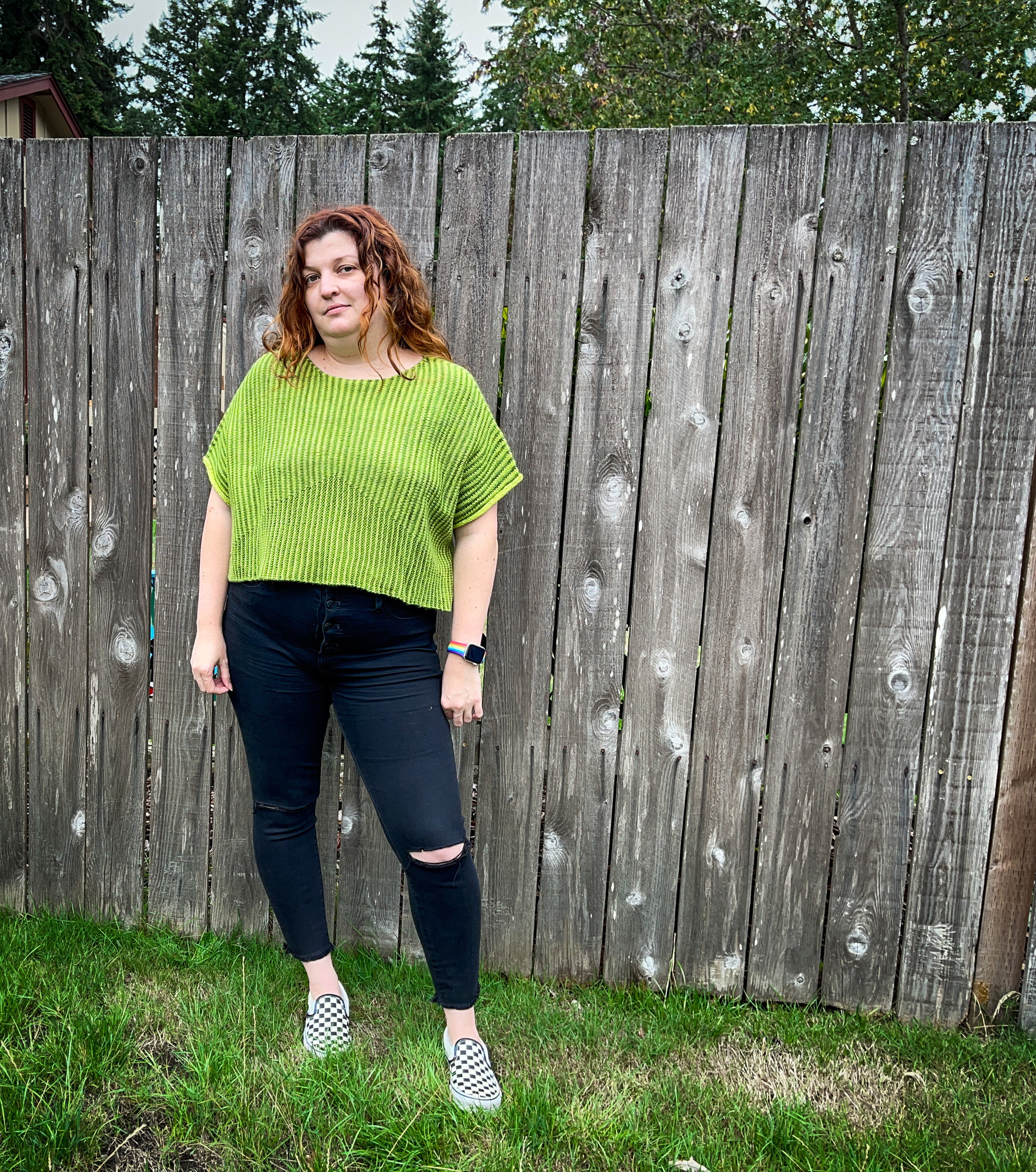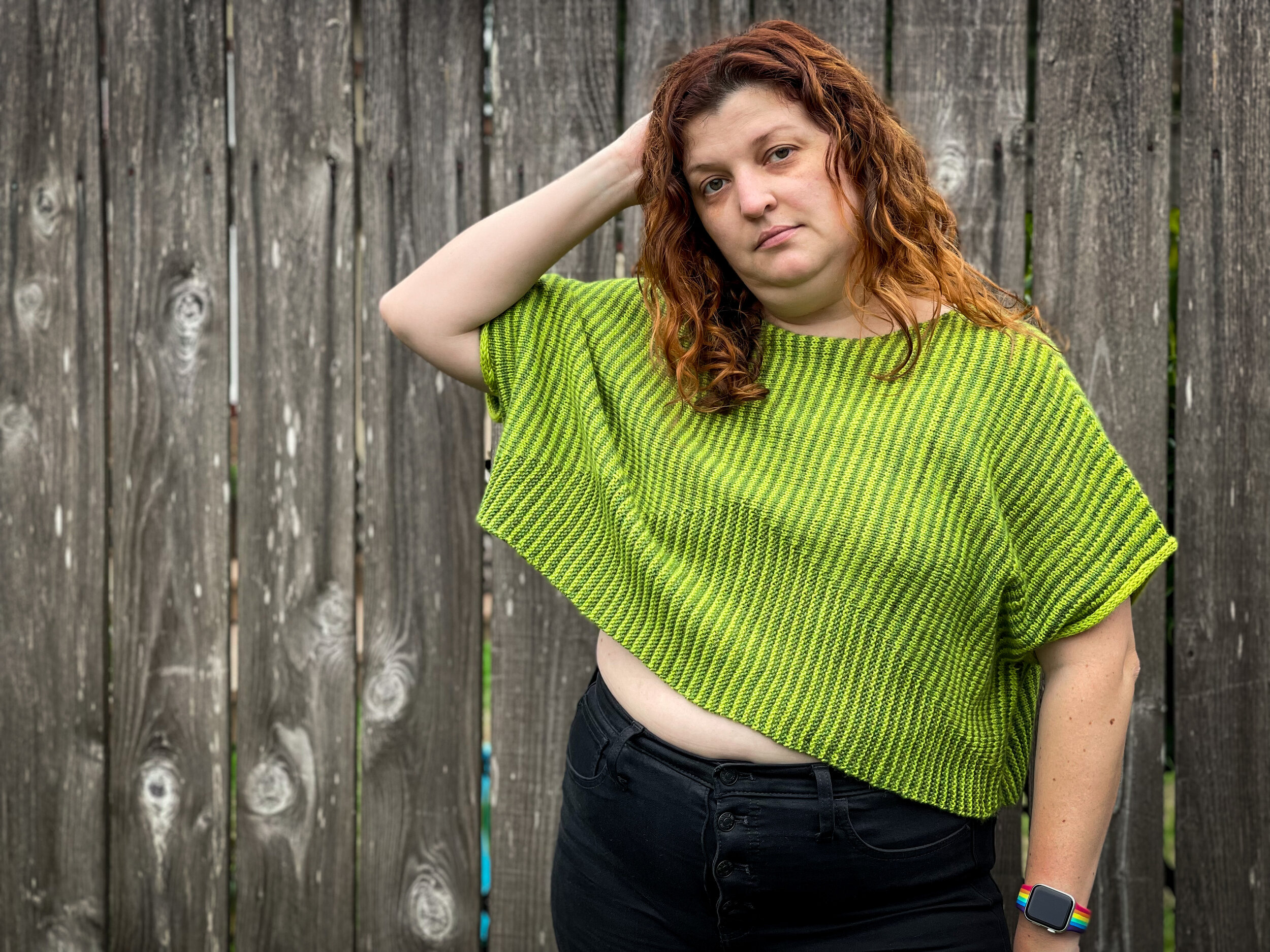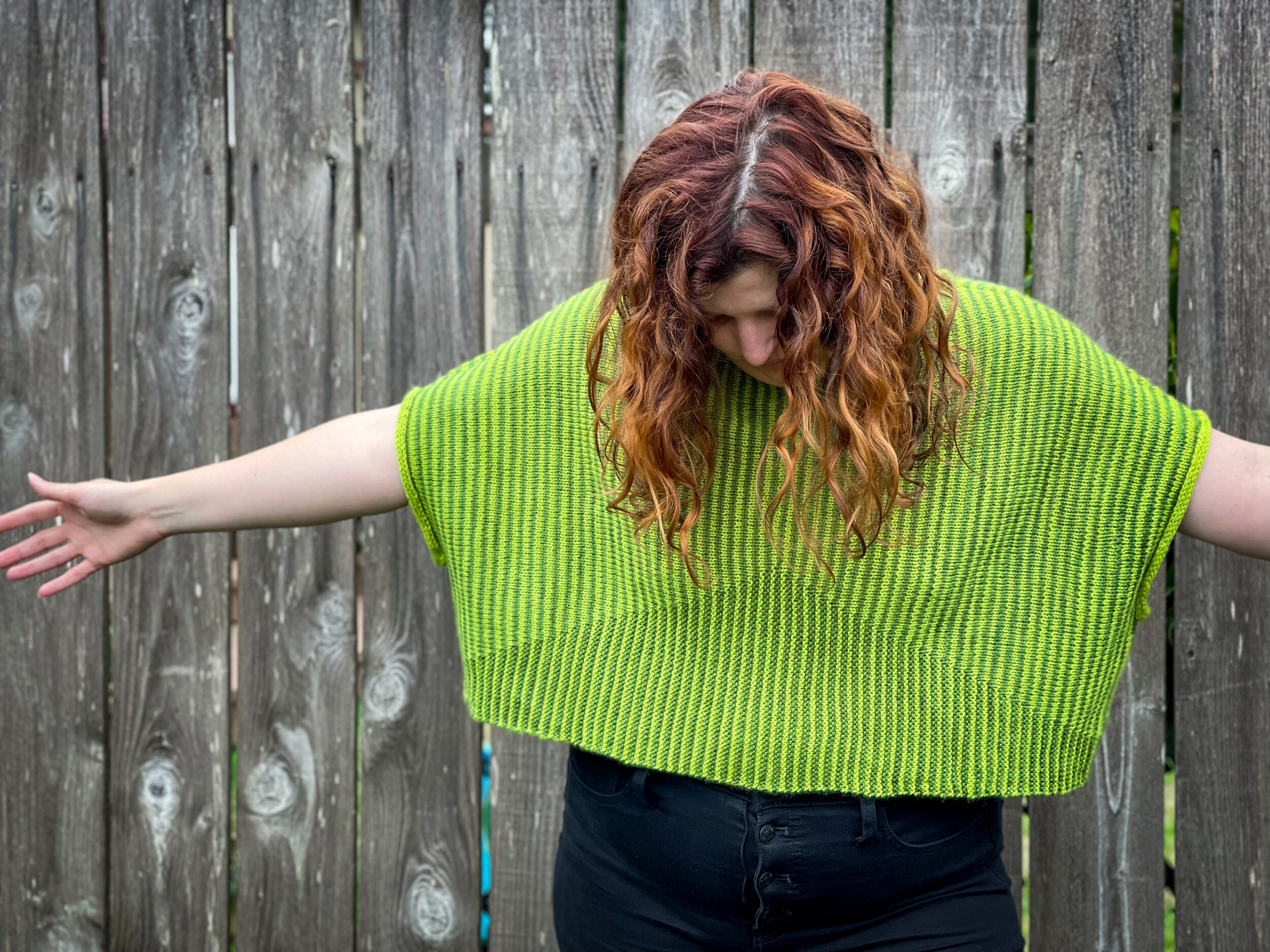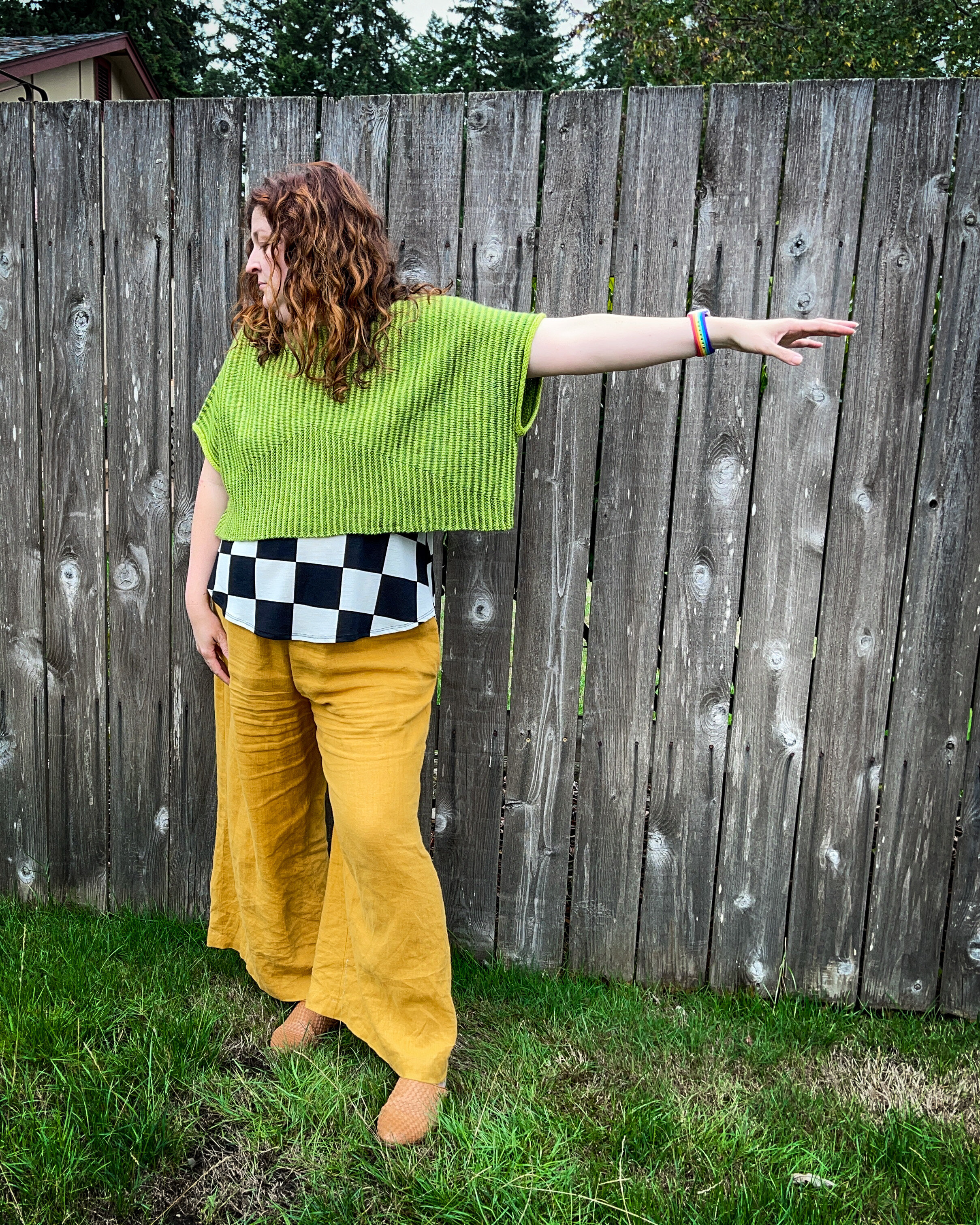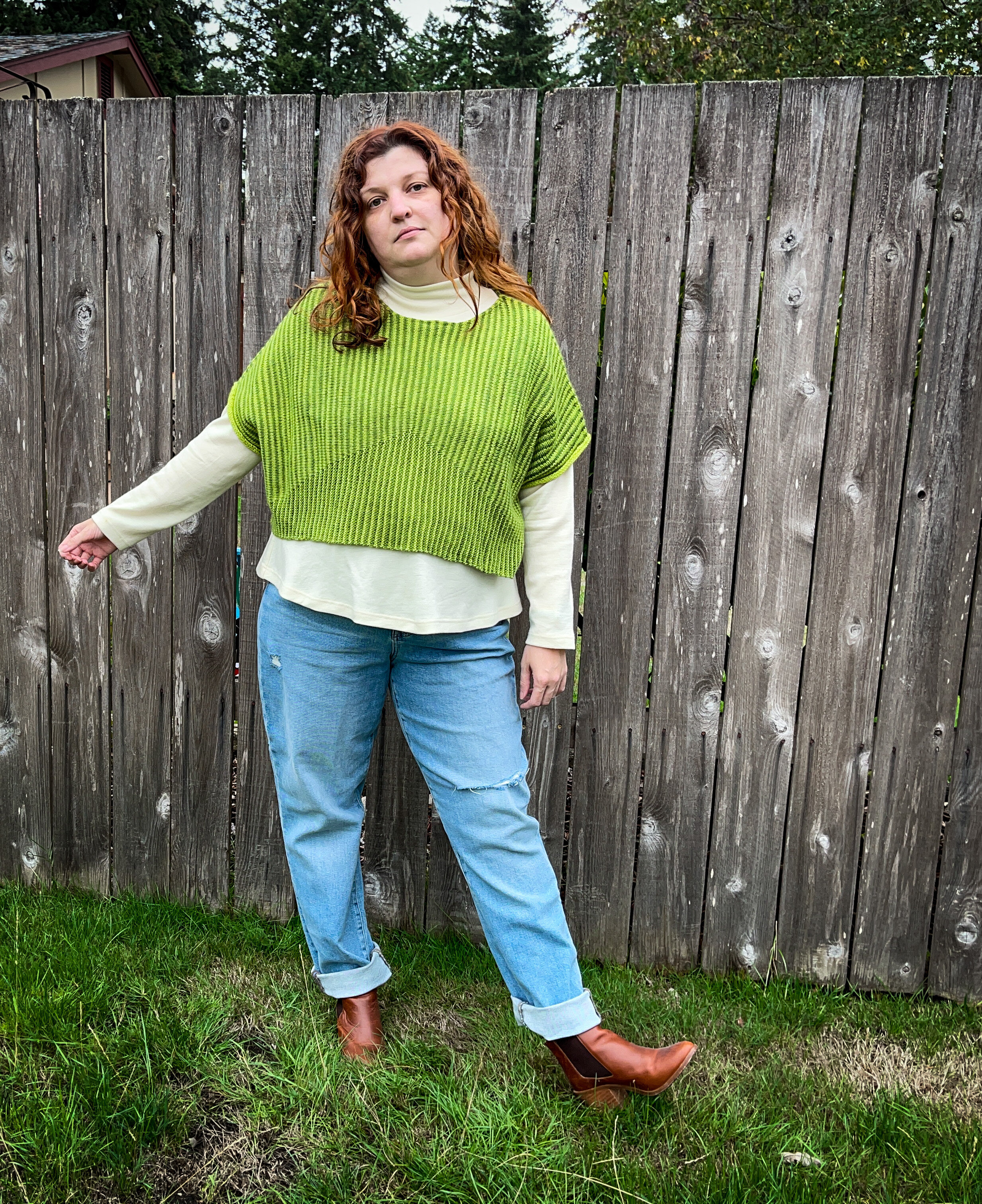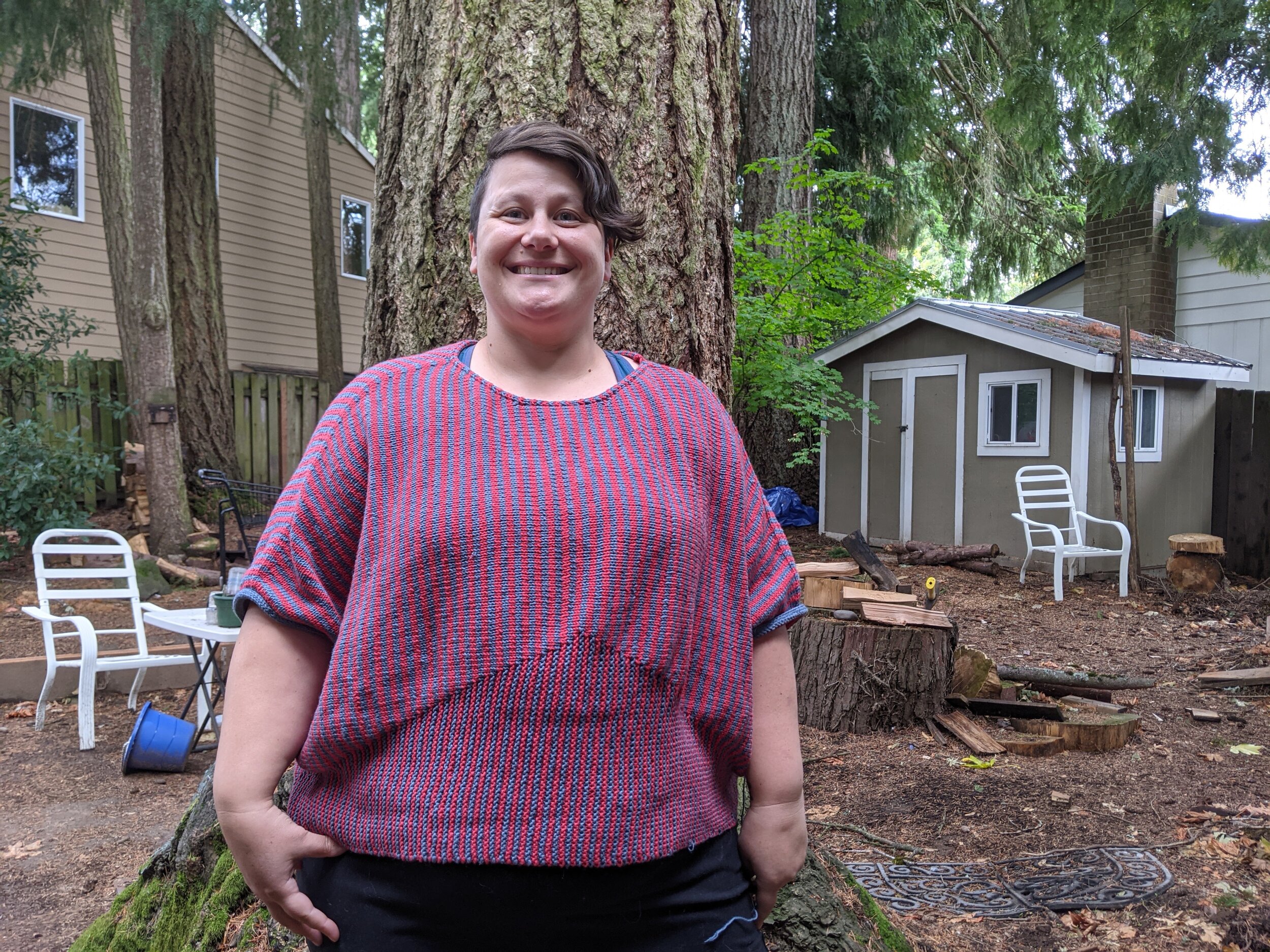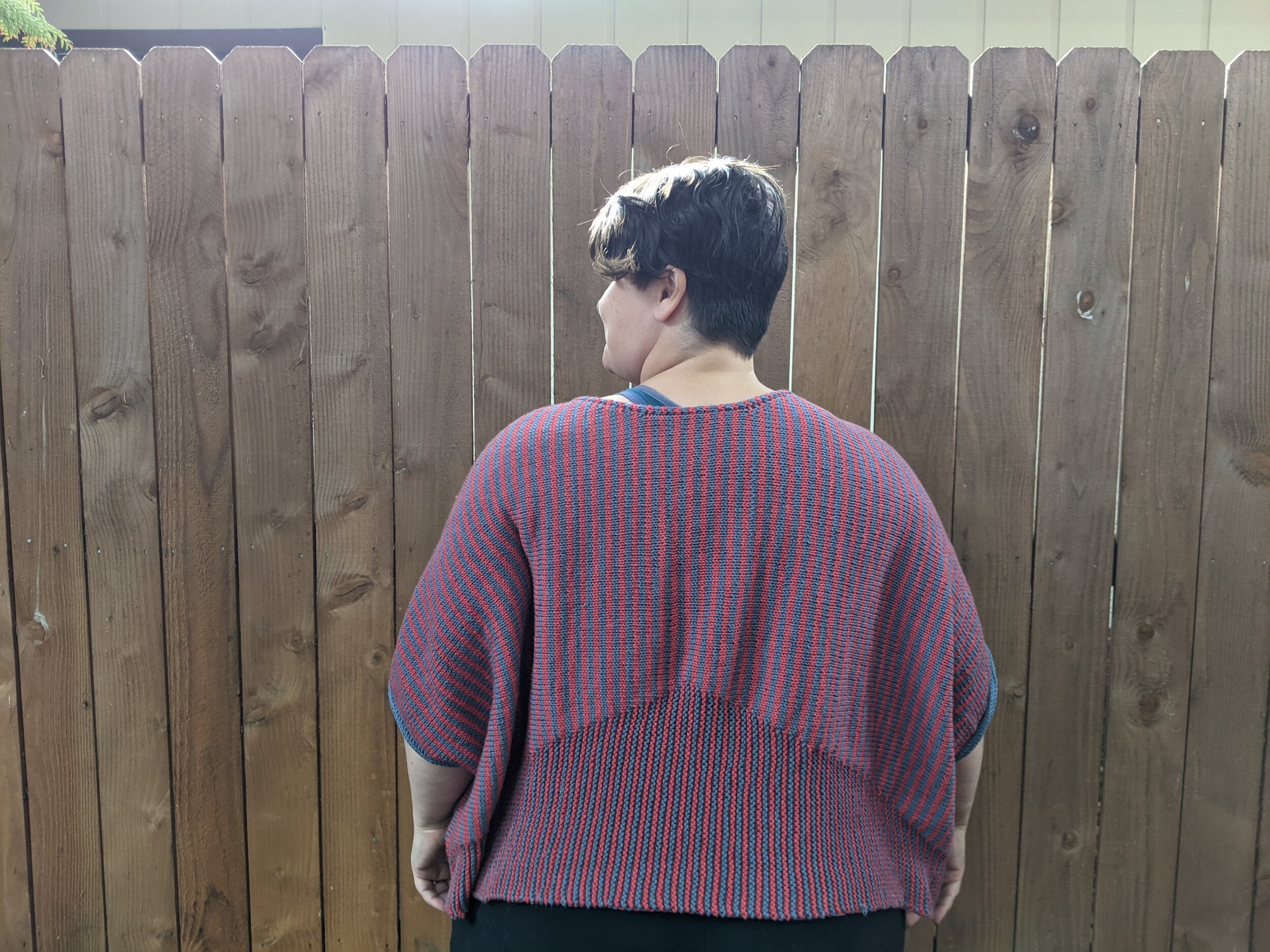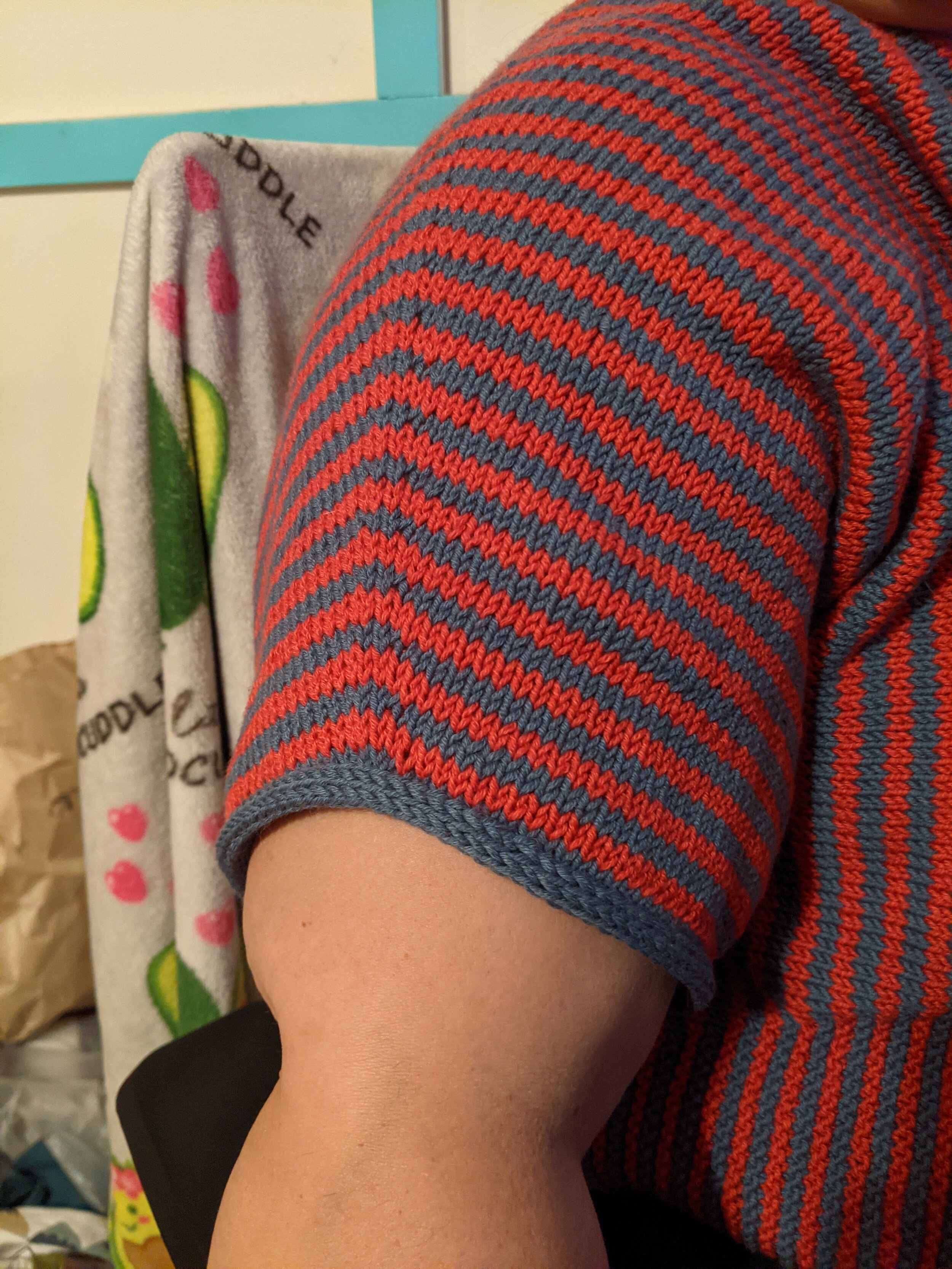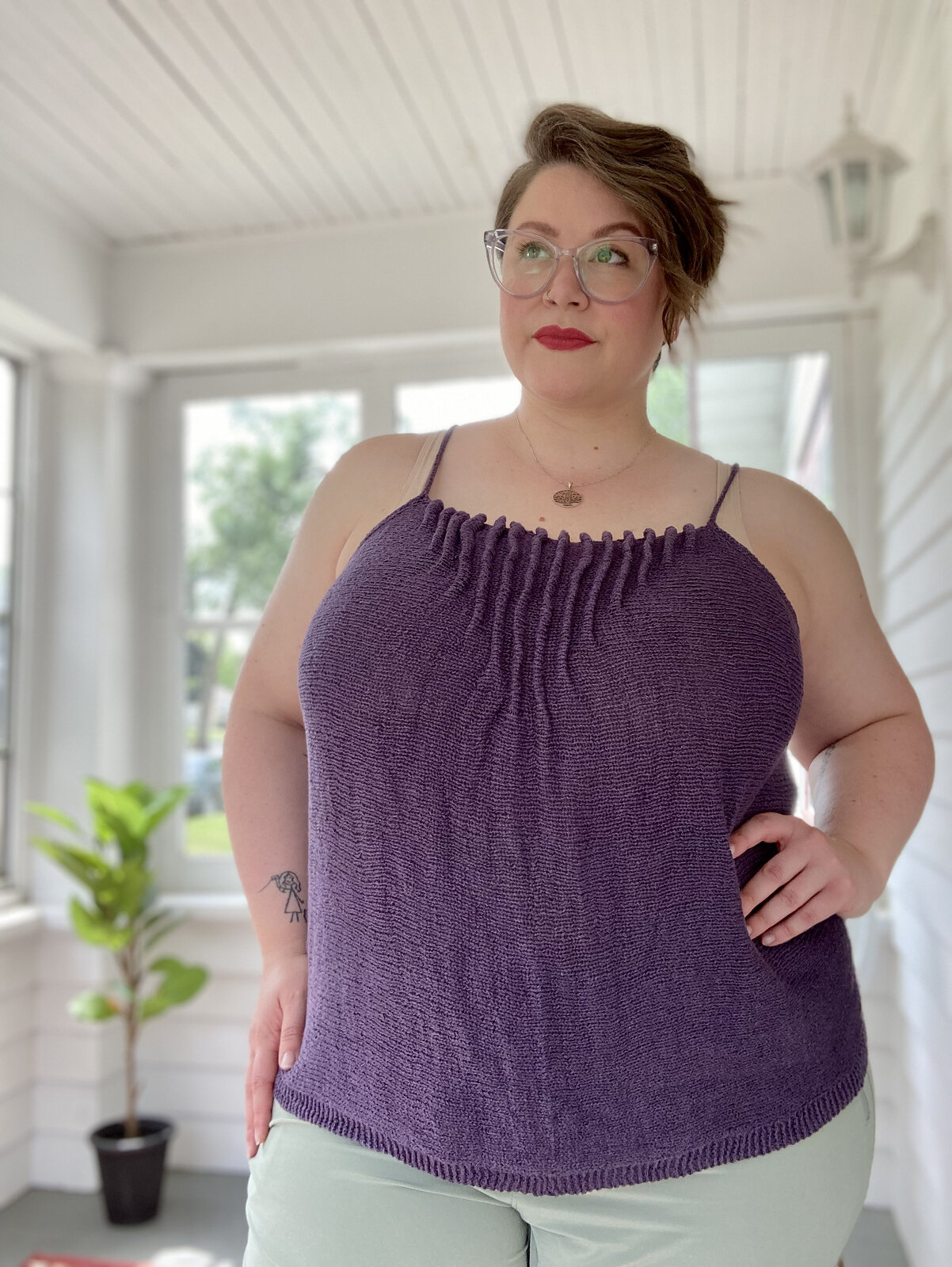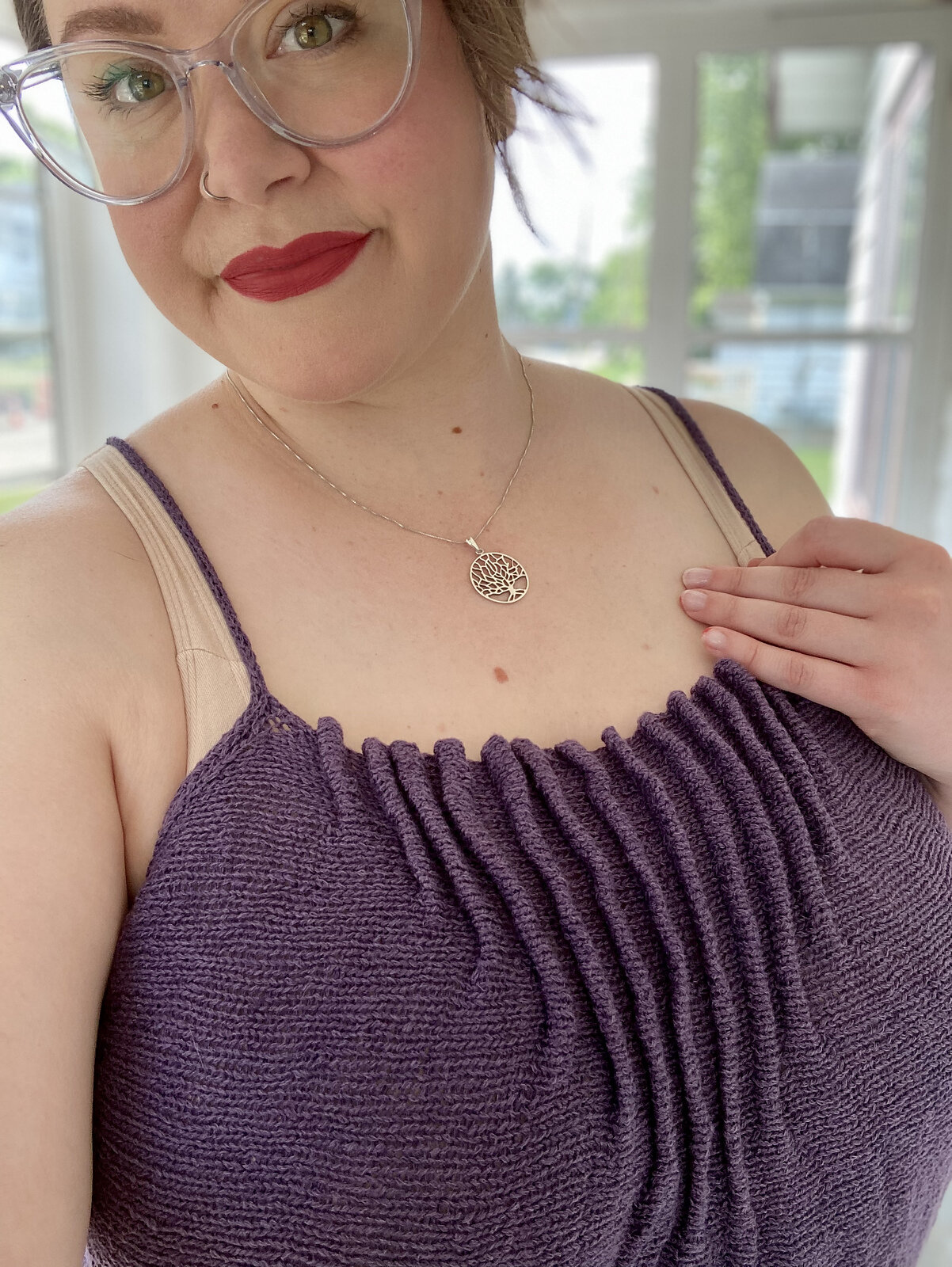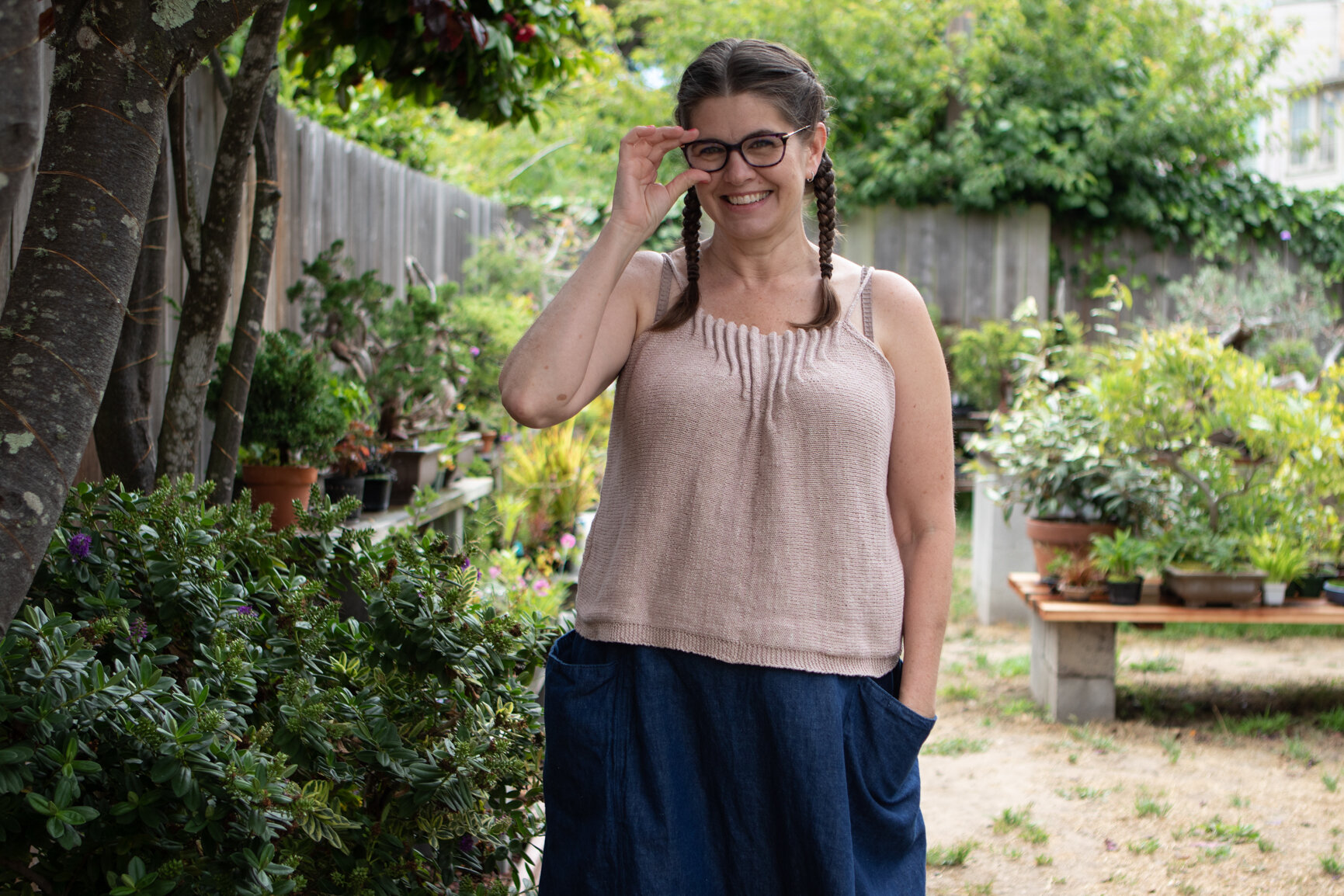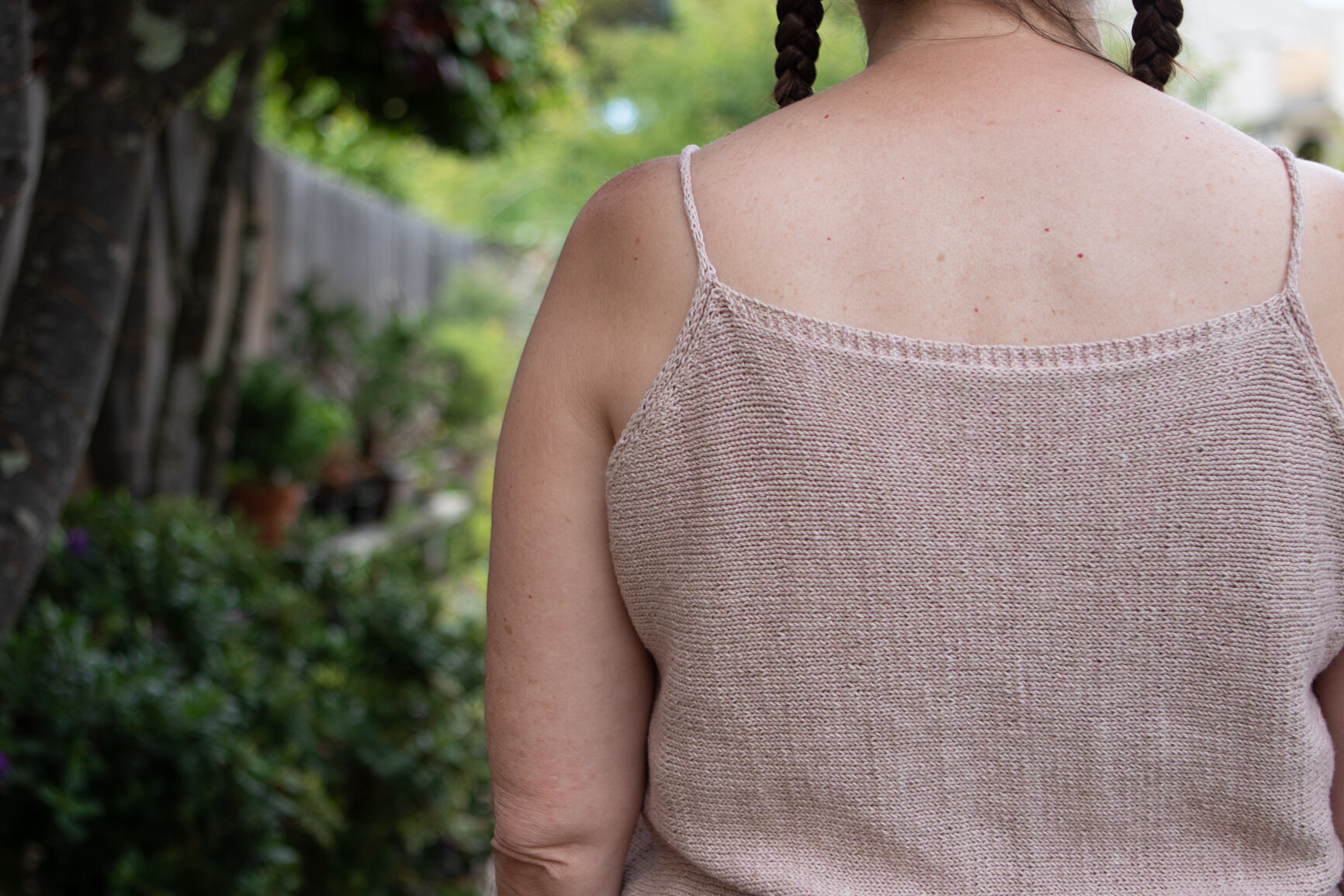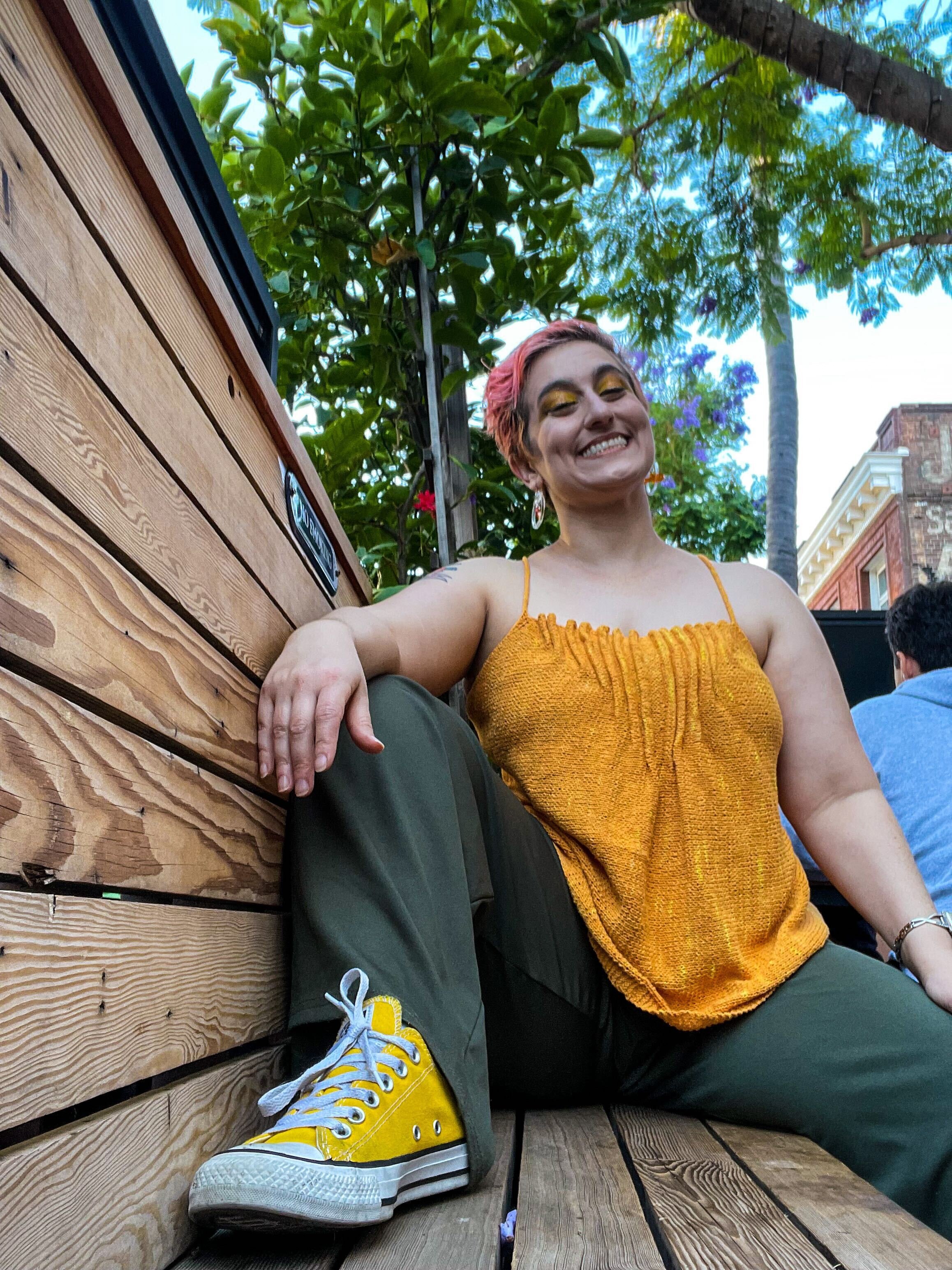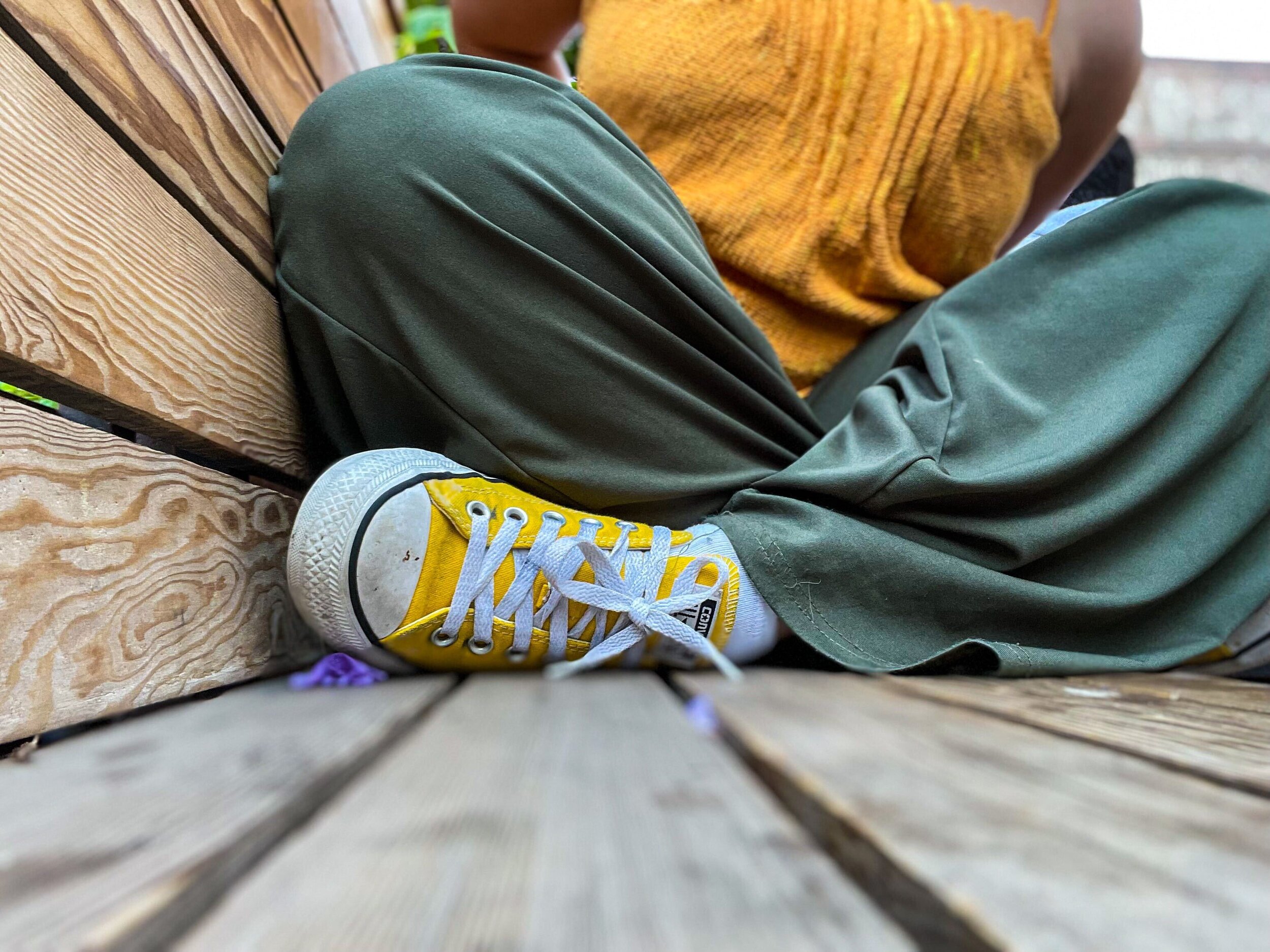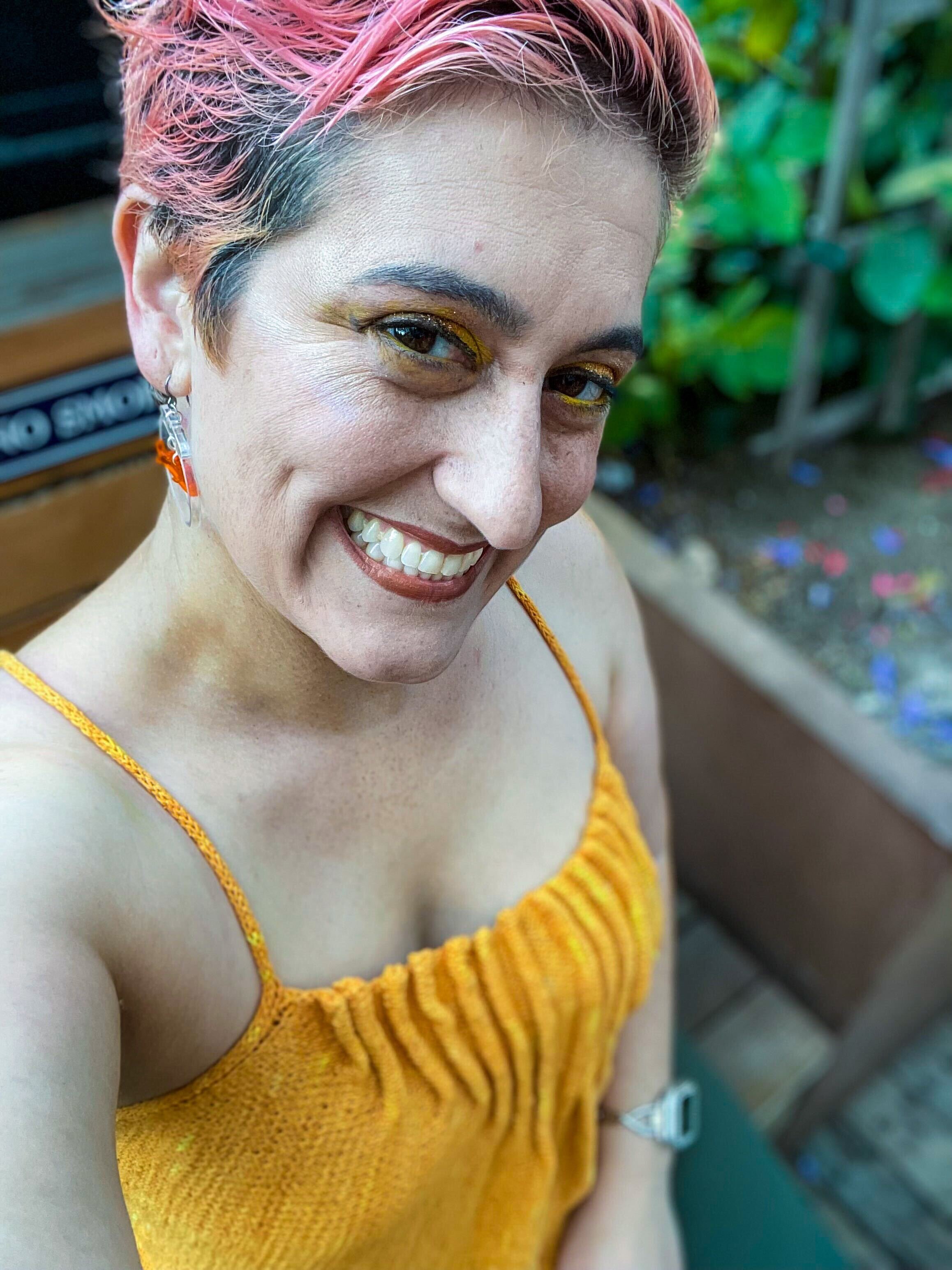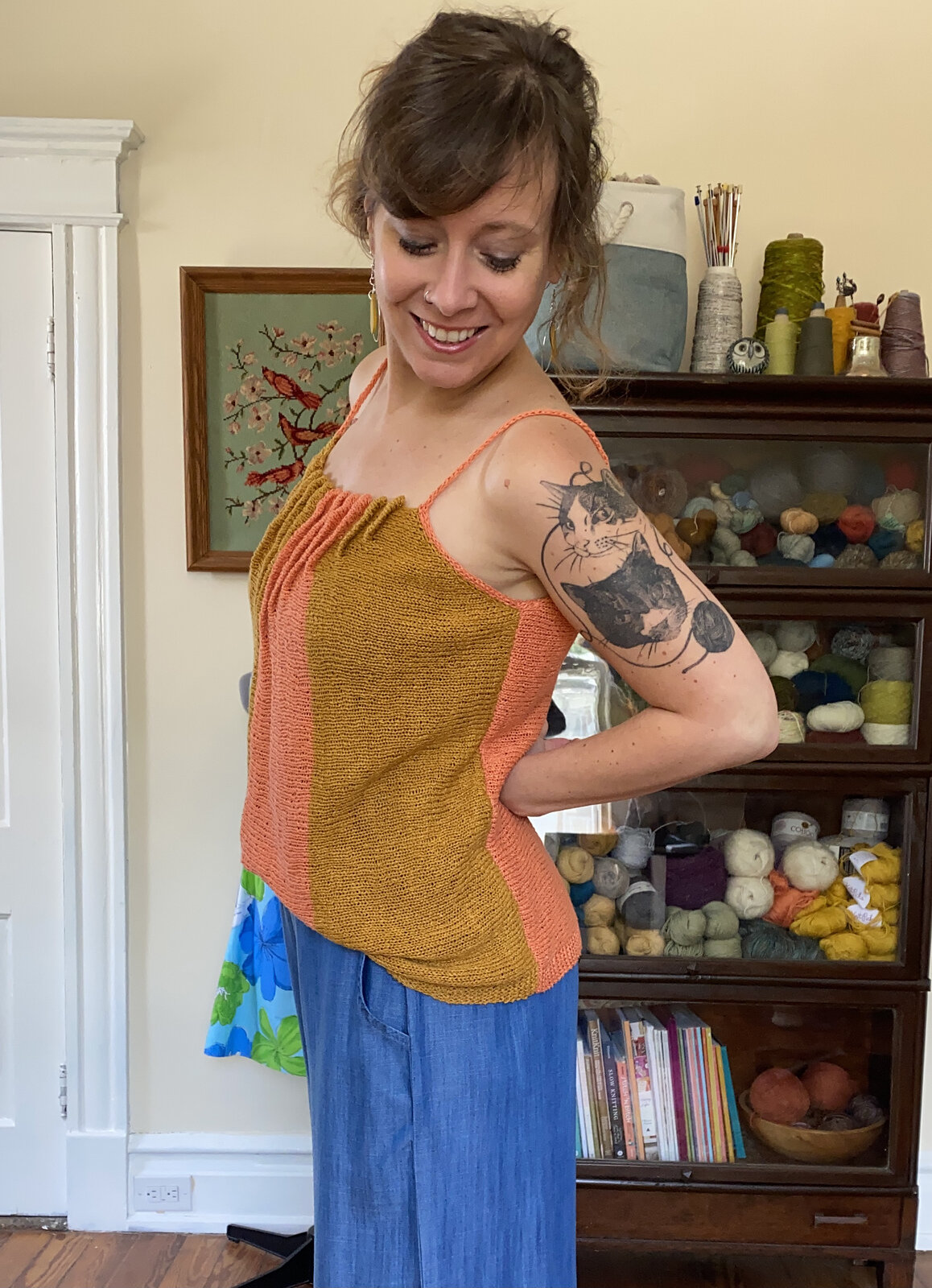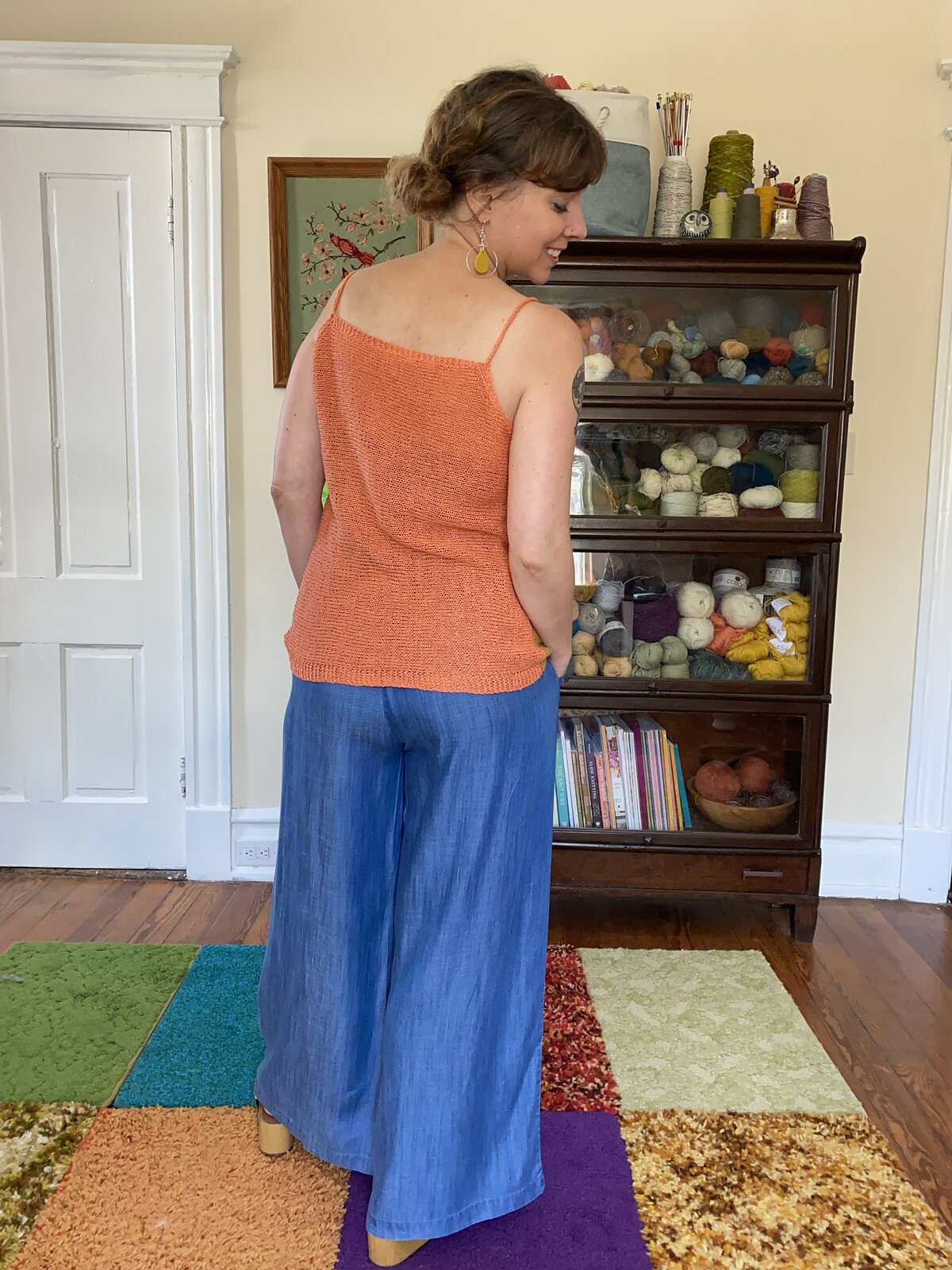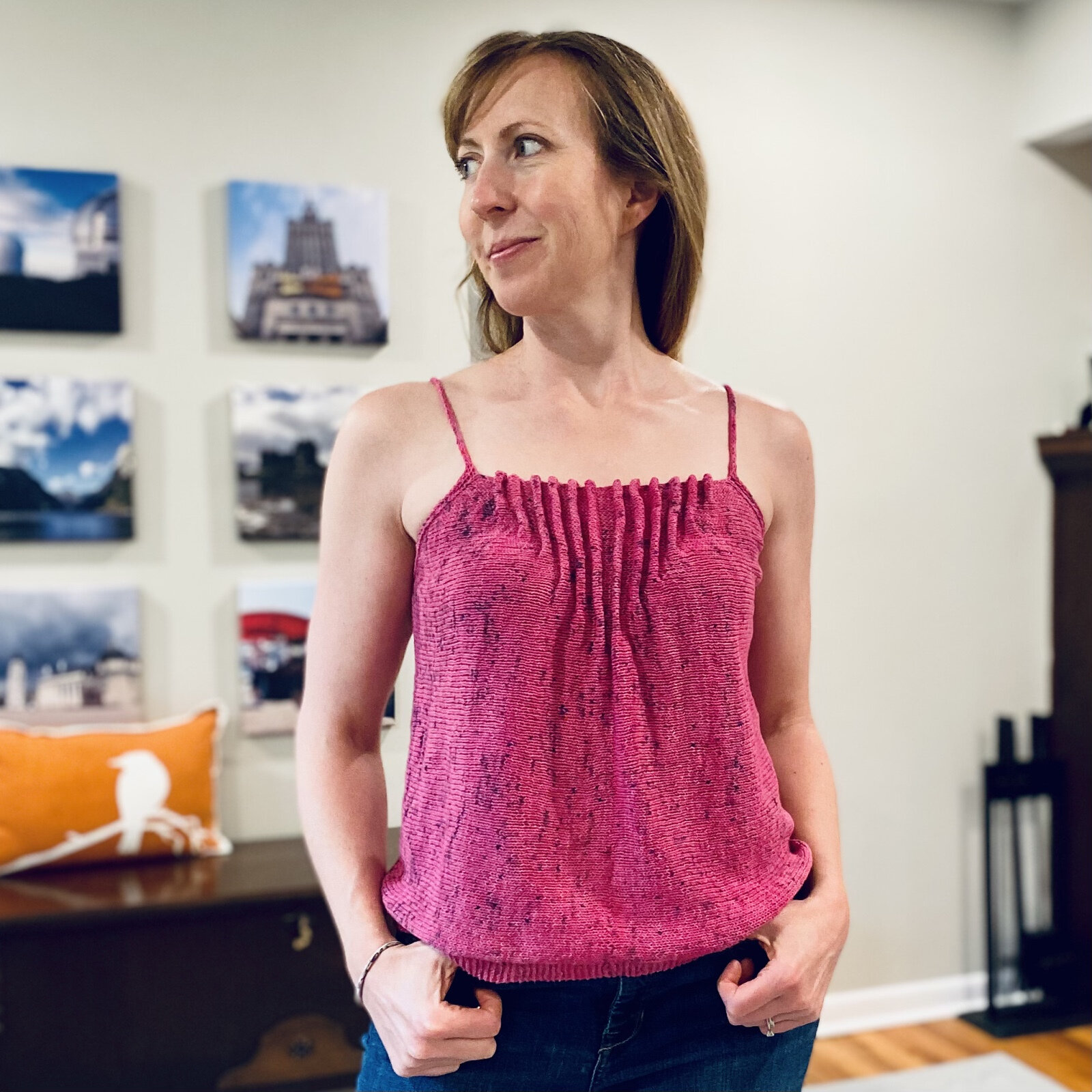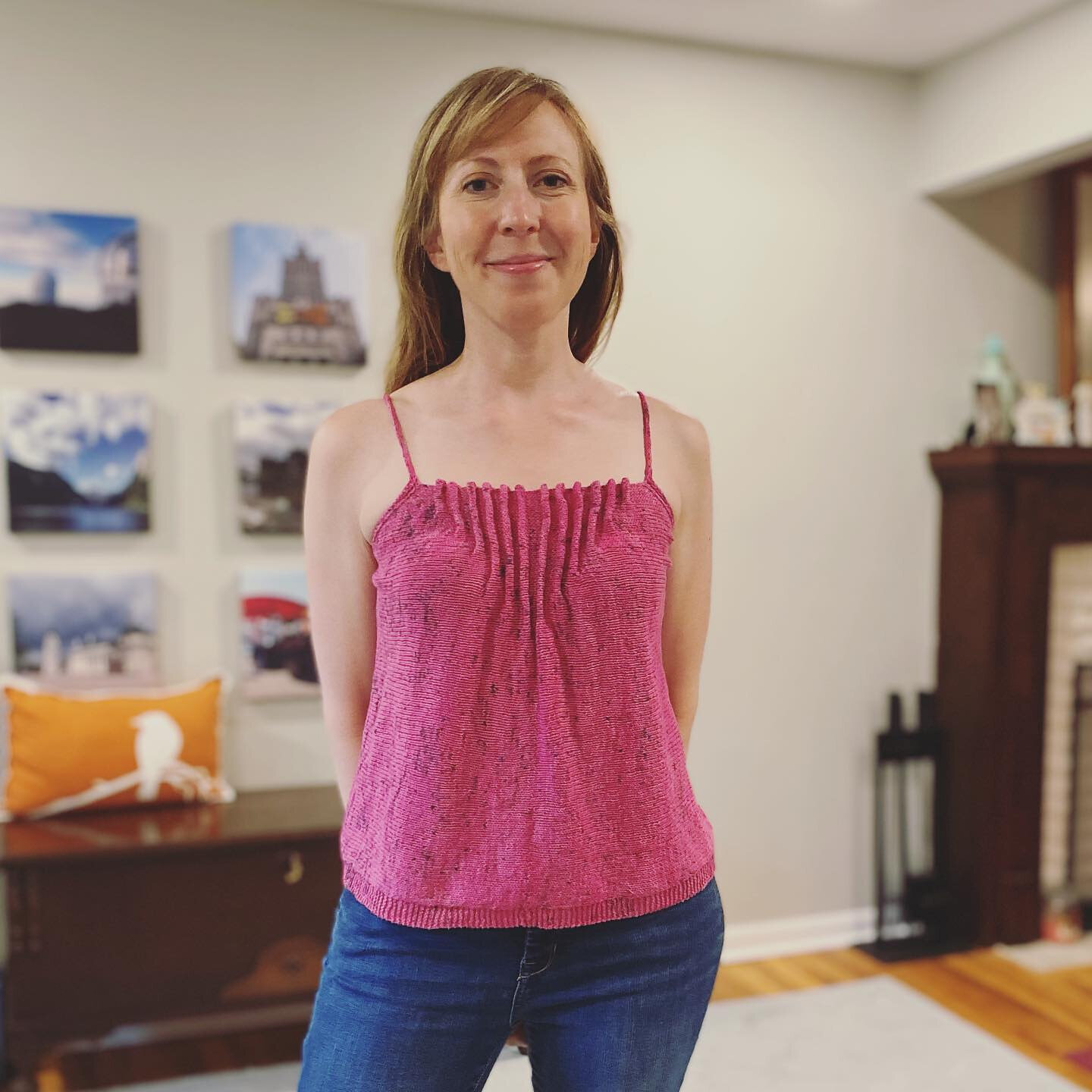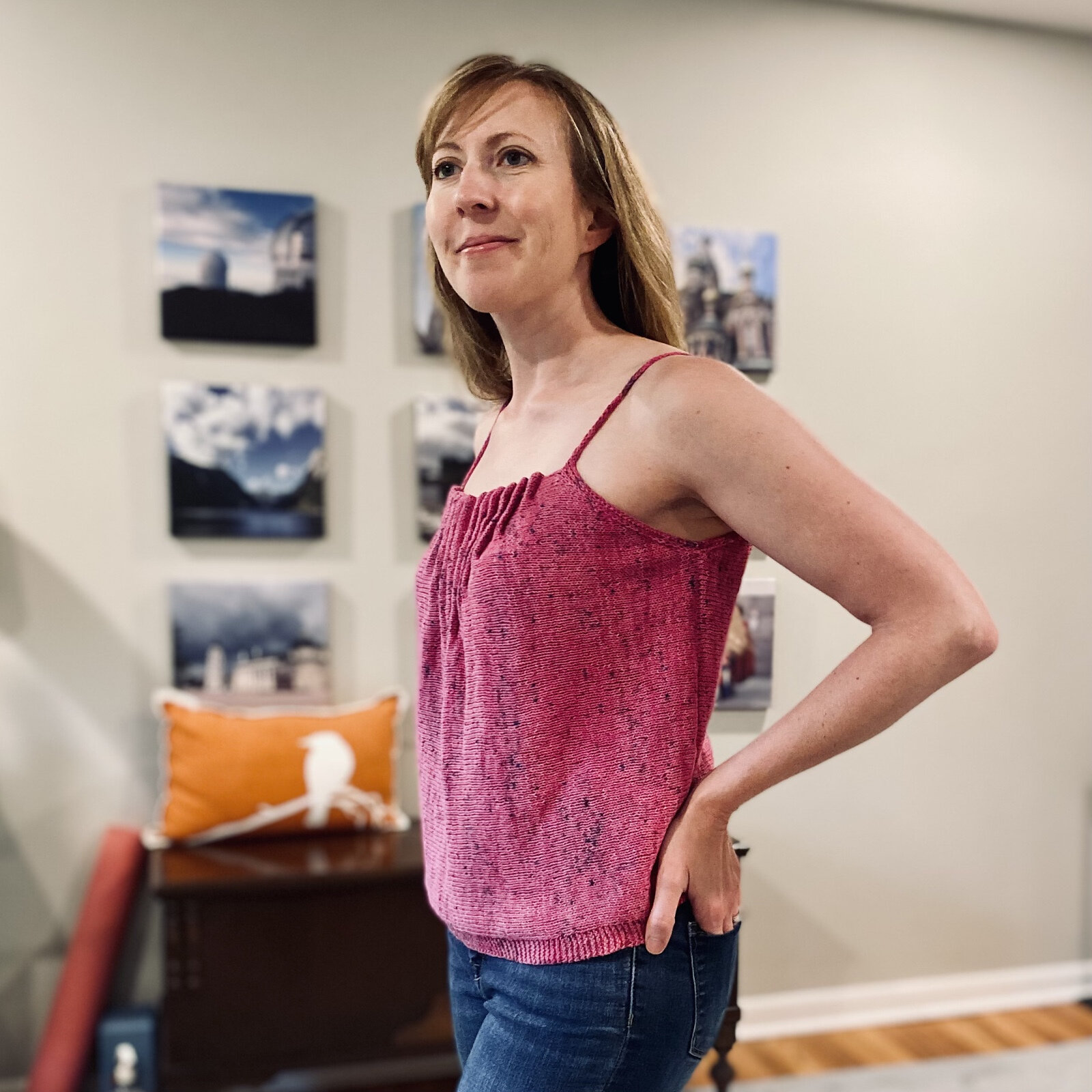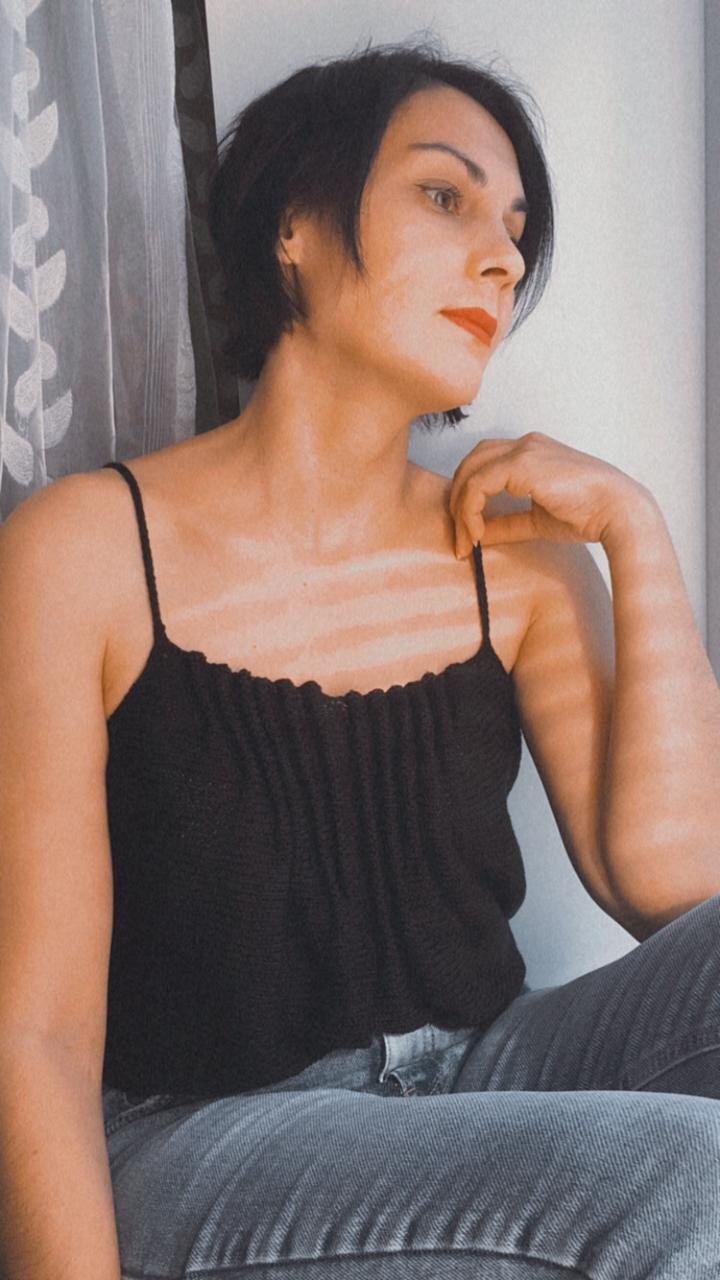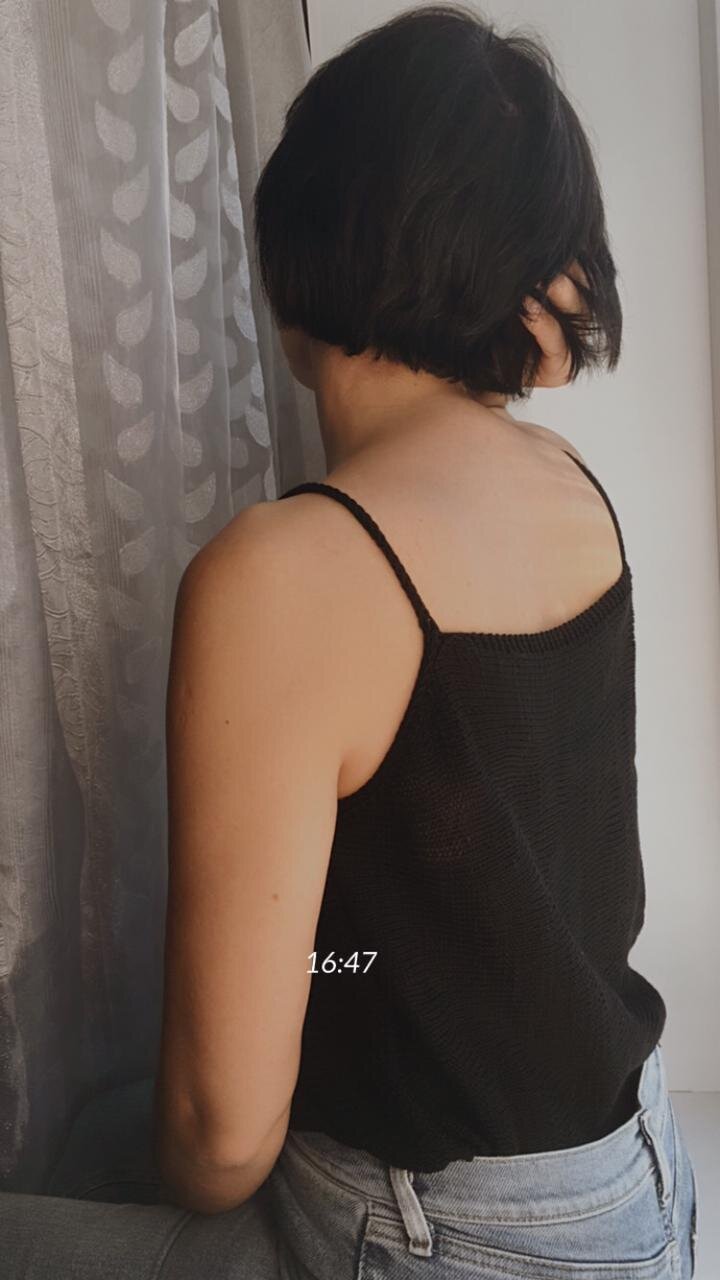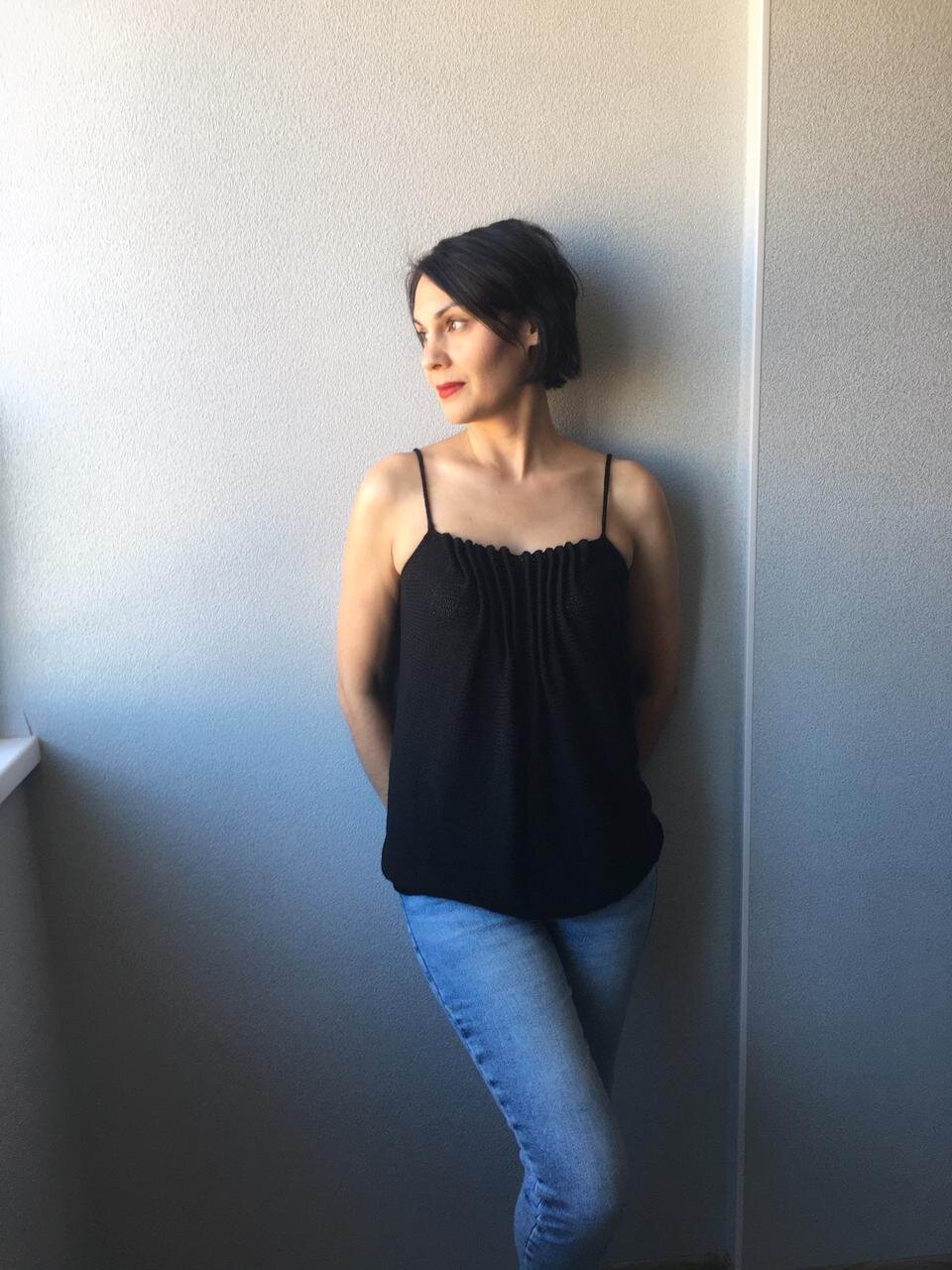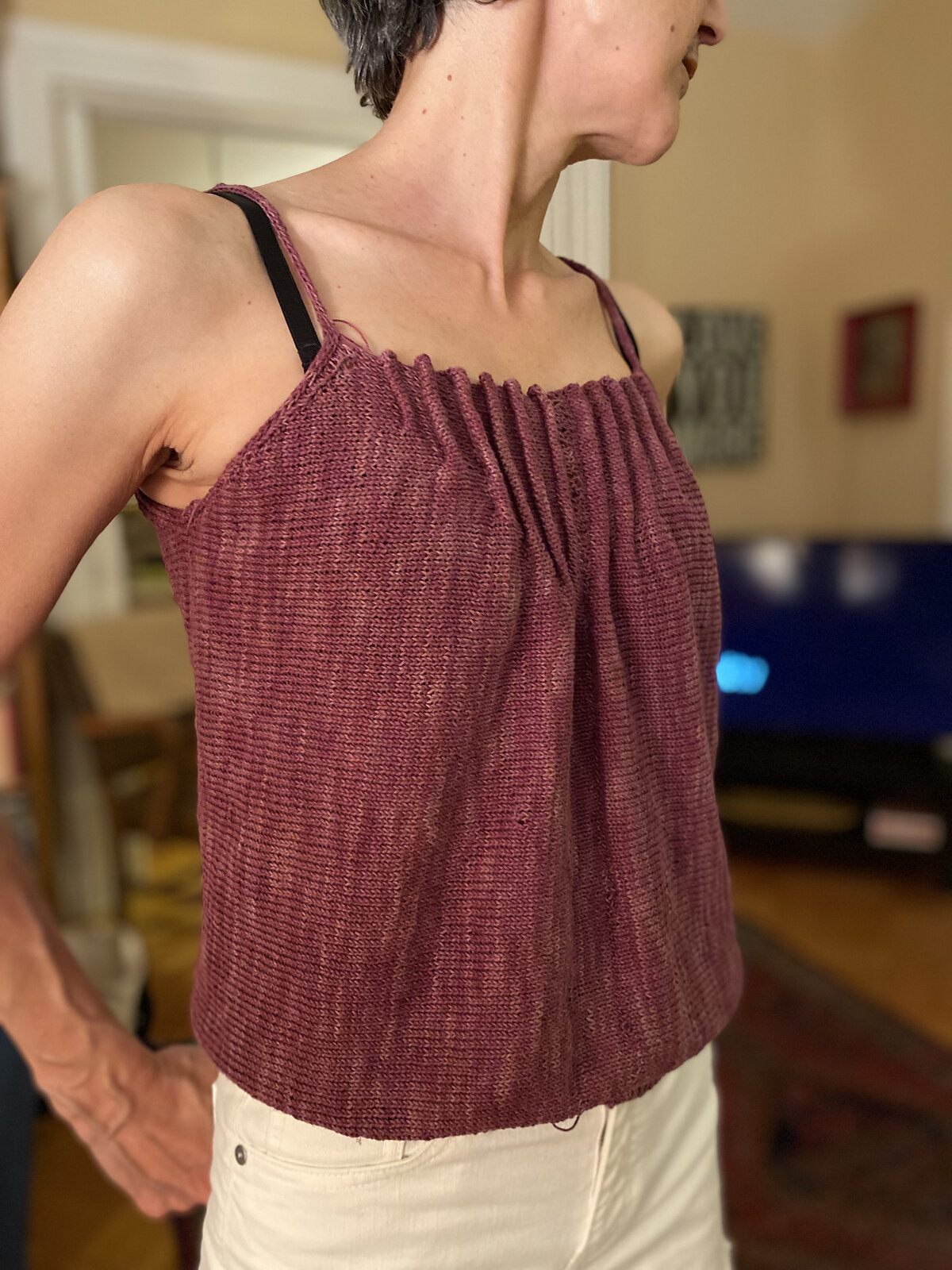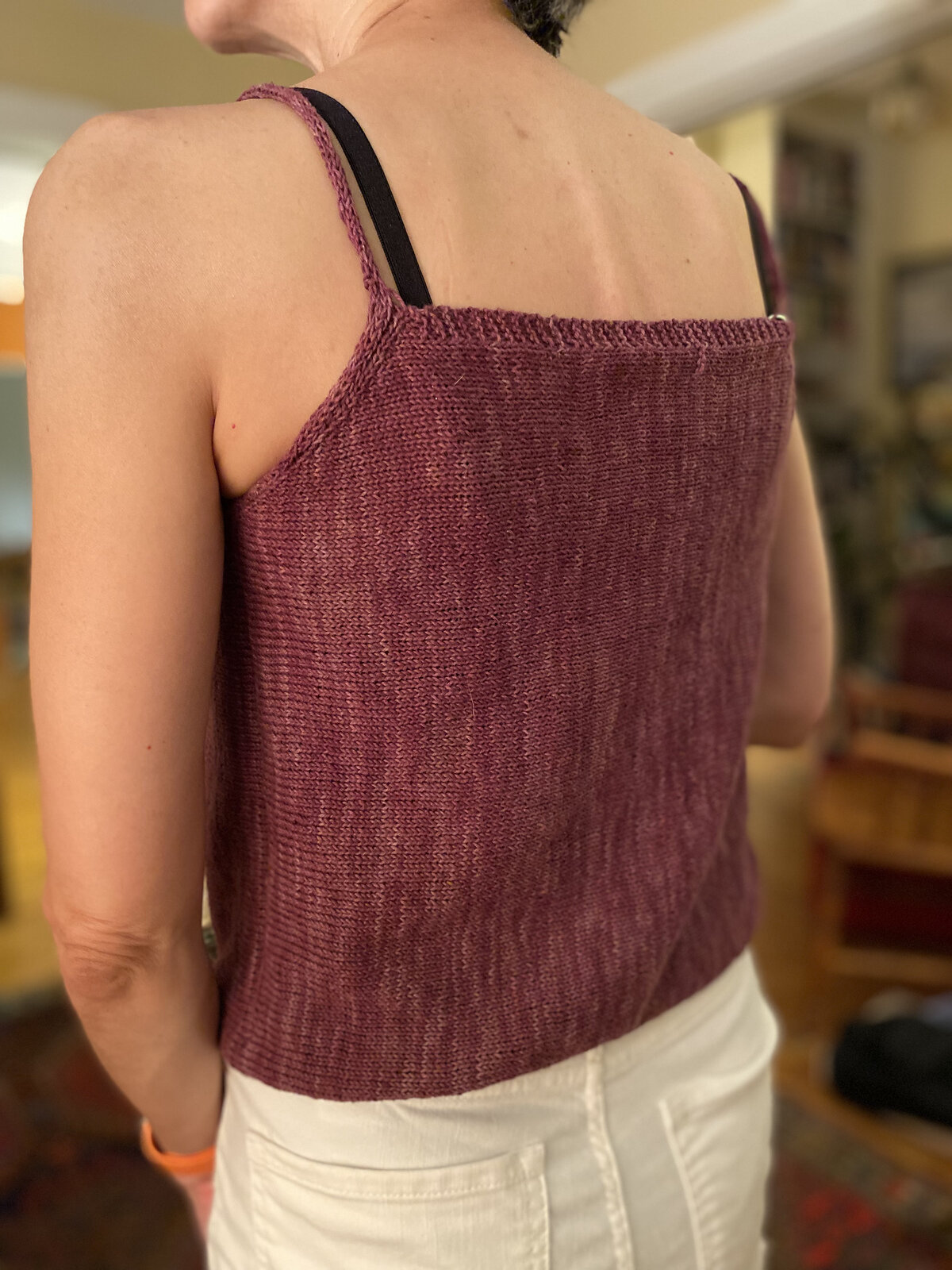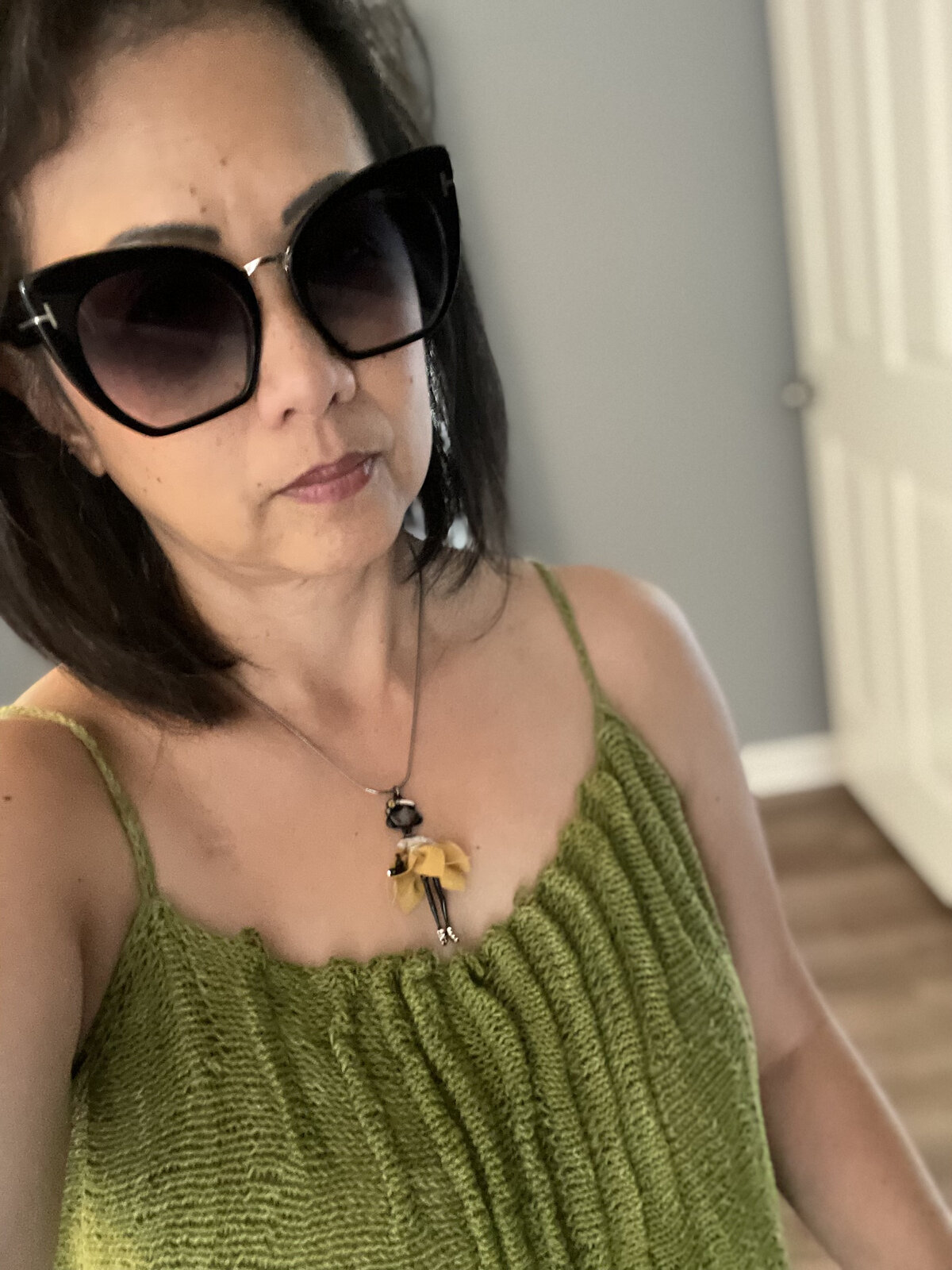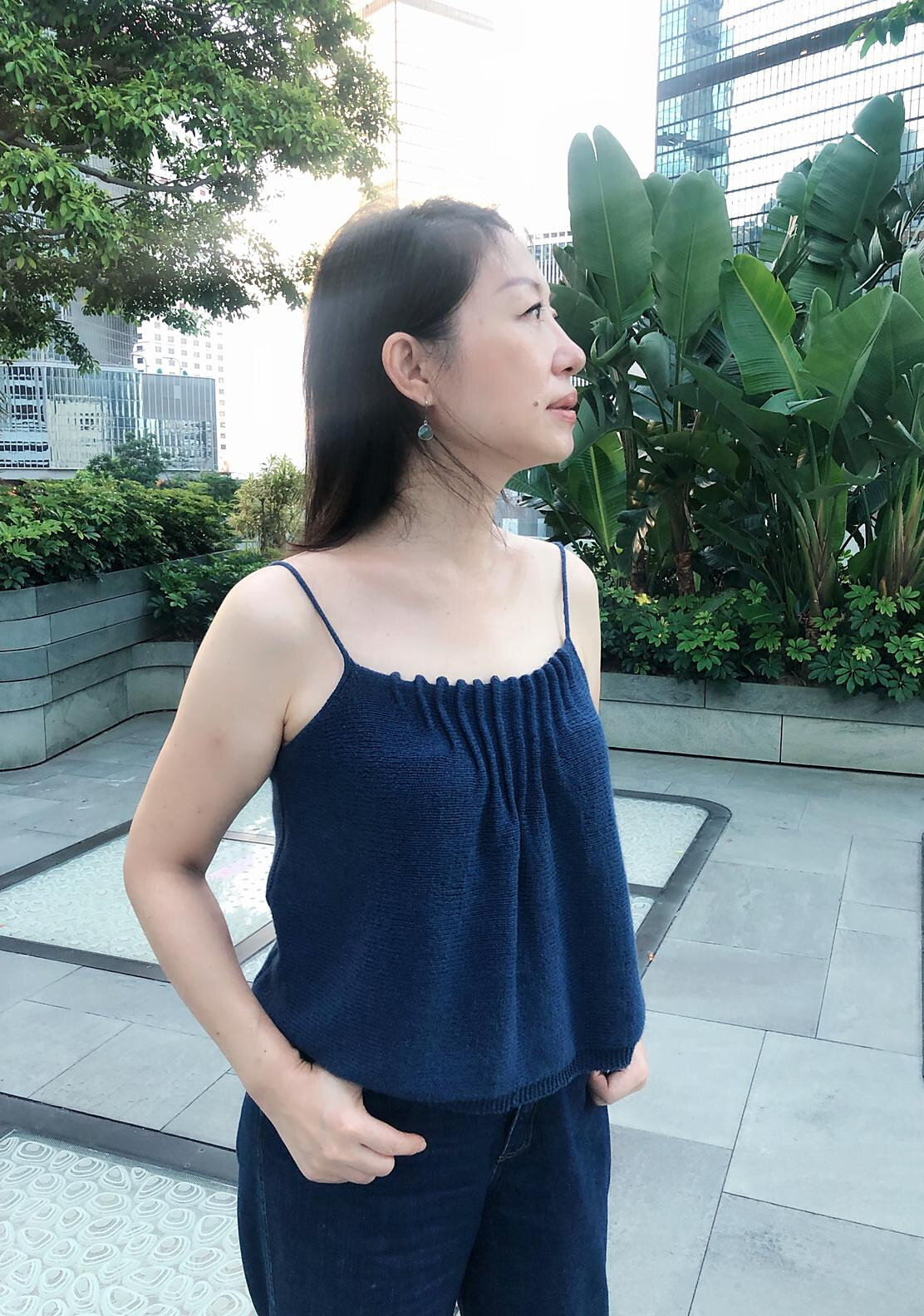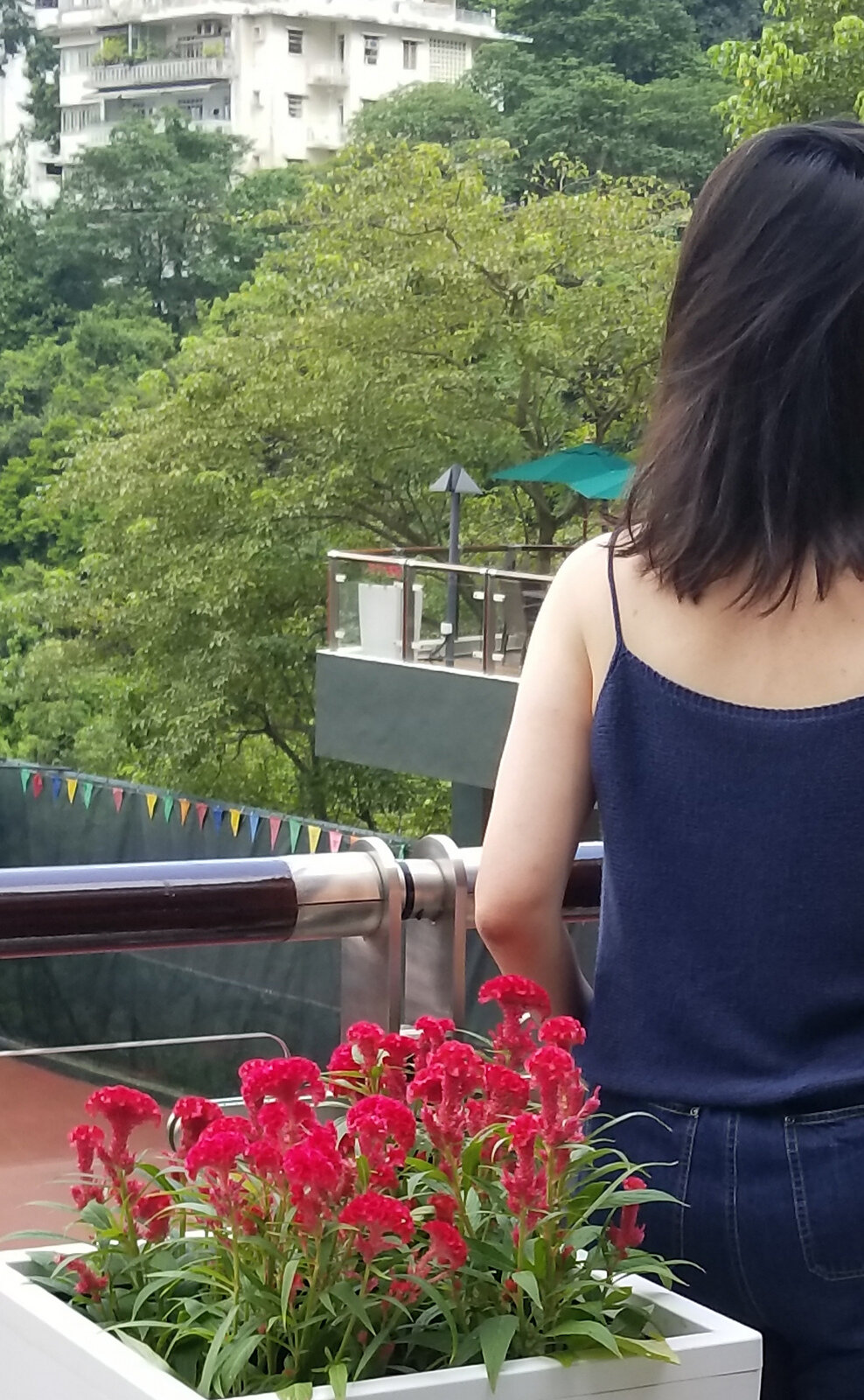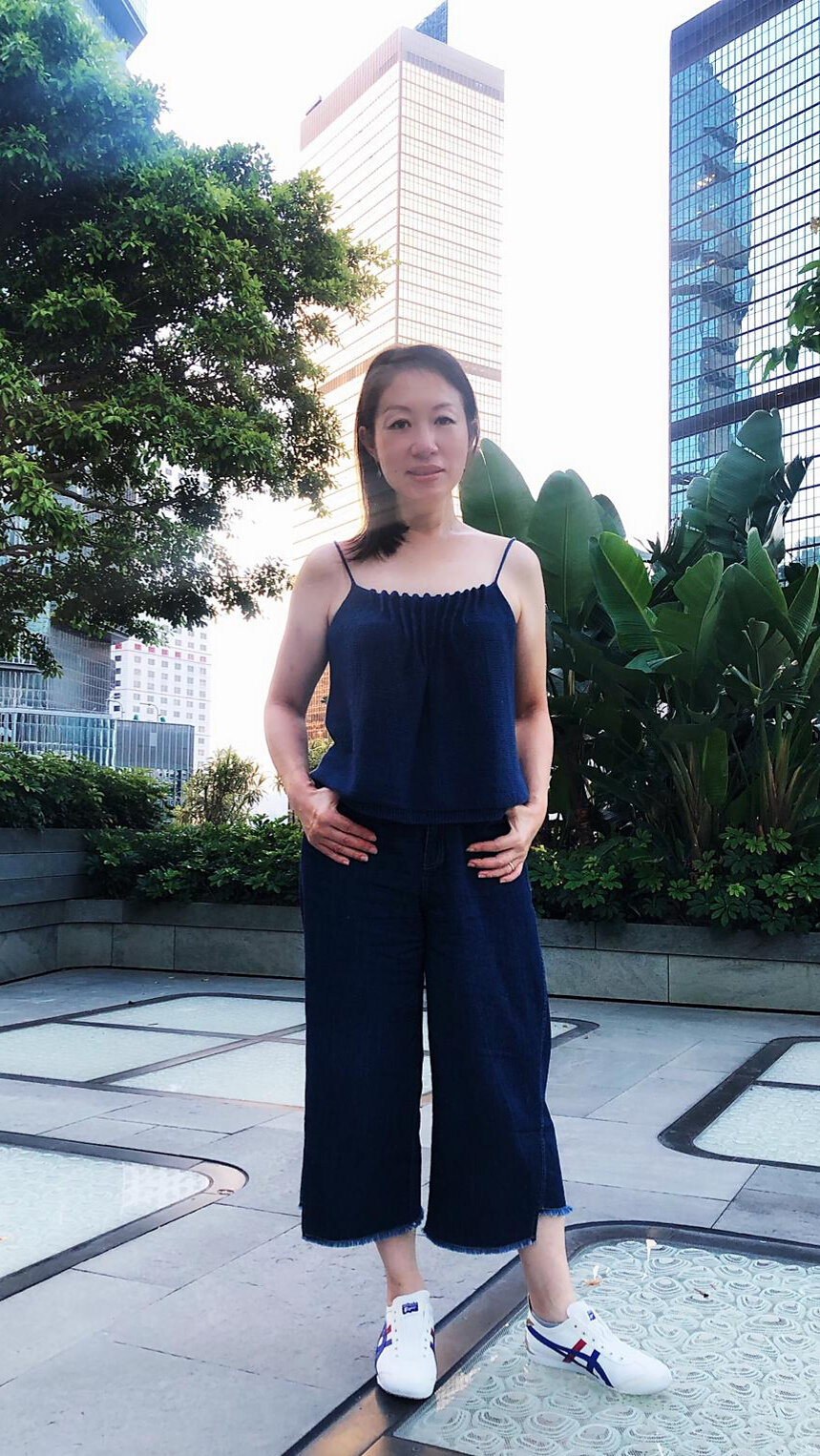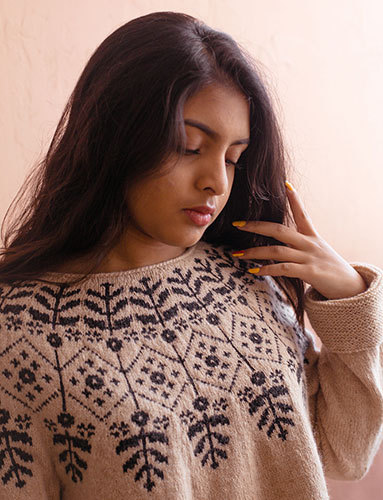A multi-color version of Petunia Pullover, a sideways knit sweater designed by Ainur Berkimbayeva for Purl Soho
Read MorePrincess Leia's Knitted Wig
Make your own knitted wig to complete your Princess Leia outfit for Halloween!
Read MorePYRAMIS PATTERN'S TEST-KNITTERS
Melissa’s Pyramis
Size 3 on 37”/94cm bust and 42.75”/109cm hip
Yarn: Premier Cotton Fair - it is soft, drapey, heavy, but it stretched out after a few wears.
Yardage: 1100 yards/1005 meters
Modification: Added 2 inches (20 extra sts)
Notes: May make a smaller size next time.
Finished measurements: Hip - 43”/109cm (became 46”/117cm after a few wears), chest - 59.5”/151cm (became 58”/147cm after wear). body length - 23”/58.5cm
Click here for Melissa’s Ravelry project page. She is also on Instagram at MisLisKnits.
Catherine’s Pyramis
Size 1 on 36.5”/93cm bust and 36”/91.5cm hip
Yarn: Purple color is Classic Elite Telluride - 82/12/6 percent alpaca/linen/Donegal
Green color is Universal Yarn Wool Pop - 50/35/15 percent bamboo/superwash wool/polyamide
Yardage: 330 yards/302 meters of each color
Modifications: She knitted it with a looser gauge (17.5 sts x 34 rows), so the finished top turned out bigger. Also, Catherine knitted three rounds of 1x1 twisted rib all in purple color.
Finished measurements: Hip - 40”/102cm, chest - 48”/123cm, body length - 18.5”/47cm.
Click here for Catherine’s Ravelry project page. She is also on Instagram at Catherine_this_life
Olha’s Pyramis
Size 2 on 35.75”/91cm bust and 37.5”/95cm hip
Yarn: Luxury Selection (90/10 cotton/silk) and Silvedd Filati (100% silk). These yarns are drapey, so the top’s hip stretched out.
Yardage: 470 yards/430 meters of grey and 427 yards/390 meters of rose
Modification: worked the neck’s I-Cord with smaller needles
Finished measurements: Hip - 46.5”/118cm, chest - 53.5”/136cm, body length - 19.75”/50cm.
Click here to see Olha’s Ravelry project page. She is also on Instagram at Olhareva
Anne’s Pyramis
Size 1 on 34.25”/87cm bust and 37”/94cm hip
Yarn: Noro Silk Garden Sock, Grignasco Champagne
Yardage: 220 yards/201 meters of each yarn
Modifications: none
Finished measurements: Hip - 37½”/95.5cm, chest - 51½”/131cm
Click here to see Anne’s Ravelry project page. She is also on Instagram at Anneswolle.
Kristina’s Pyramis
Size 5 on 47.75”/121cm bust and 47.25”/120cm hip
Yarn: Amy Butler Belle Organic DK from Rowan, 50/50 percent wool/cotton
Yardage: 1179 yards/1078 meters in the garment, the finished garment weighs 449g.
Modification: Added bust dart as suggested in the pattern
Notes: Gauge was spot on on the gauge swatch, but the garter stitch row gauge really stretches out in a large garment even if blocked smaller
Finished measurements: Hip - 53.5”/136cm initially, 56”/142cm after wear, chest - 67”/170cm initially, 63”/160cm after wear, and body length - 20.5”/52cm initially, 22”/56cm after wear
Click here to see Kristina’s Ravelry project page. She is also on Instagram at Spinnkrok.
Cesca’s Pyramis
Size 2 on 35.5”/90cm bust and 37.75”/96cm hip
Yarn: Juniper Moon Farm Patagonia Organic (Sport weight, 100% wool) and De Rerum Natura Ulysse (Sport weight, 100% wool)
Yardage: dark color - 458 yards/419 meters and light color - 466 yards/426 meters
Modification: added 3/4 sleeves, used provisional crochet cast-on to work a 3-needle-bind-off on the side seams and to have live sts for the armhole finishing
Finished measurements: Hip - 41.25”/105cm, chest - 49.5”/126cm, and body length 20.75”/52.5cm
Click here to see Cesca’s Ravelry project page. They are also on Instagram at FelixAguilarCrafts.
Melissa’s Cropped Pyramis
Size 4 on 42”/107cm bust and 46”/117cm hip
Yarn: Neighborhood Fiber Co's Capital Luxury Sport yarn (80/10/10 percent merino/cashmere/silk) - the yarn is smooth and soft with some drape.
Yardage: 434 yards/397 meters of the darker color and 462 yards/422 meters of the second, lighter color
Modification: added 2 rows of the second color at the side seams to continue the pattern, omitted the neck I-Cord
Notes: should only add a single row on one edge next time, so as to make one row of the second color, then add the second row with mattress stitch
Finished measurements: Hip - 54”/137cm, chest - 56”/142cm, and body length - 18”/46cm
Click here to see Melissa’s Ravelry project page. She is also on Instagram at MG.wears.things.
Beth’s Pyramis
Size 7 on 44”/112cm bust and 56”/142cm hip
Yarn: Cascade Yarns Anchor Bay - it has form without being too stiff.
Yardage: 1300 yards/1188 meters
Modifications: none
Notes: The top fits bigger than expected
Finished measurements: Hip - 65”/165cm, chest - 78”/198cm, and body length - 21”/53.5cm
Click here to see Beth’s Ravelry project page. She is also on Instagram at SchuffBeth.
Flying Home Top Pattern Release and Test-Knitters' versions
Flying Home Top is finally ready for its release and I would like to take a moment to chat about the pattern itself, the amazing pattern testers, and their versions of this top.
First off, the top you see on the pattern cover page is Size 2 modeled by me (my upper bust is 33”/84cm and full bust is 35”/89cm). I have about 7.5”/19cm of positive ease around my full bust, but it doesn’t look like it, does it? It’s because the tucks get longer towards the center and each tuck gradually adds more ease to the front and creates an A-line shaping. The top is knitted sideways, with the front worked in two pieces sewn in the front center and the back is worked as one piece. The sides are seamed with mattress stitch.
The pattern includes notes about adjusting sizes for bigger cup sizes and adding length to the top in general or just the front by adding bust darts.
I knitted this sample with Seismic Yarn Cellular in Thai Ice colorway. This base is a 60/40 percent blend of organic cotton and linen. This yarn costs $28 per 100g skein, and I used 2 skeins of it, so it was $56 total, plus shipping. I loved knitting with this yarn as it was soft (for a linen blend yarn), round, dense, and drapey. I also liked that it’s not very slippery like the 100% linen yarns I have tried. It felt very much like knitting with cotton, but it is definitely drapier than pure cotton, and drapiness is what I was after for this design!
I also made a second sample using a more affordable yarn - Knit Picks’ Lindy Chain. The content is very similar to the previous yarn; it’s also a blend of cotton and linen, but there is much more linen here (70% linen and 30% cotton). Plus, the yarn has the chainette construction. While I was able to get the gauge and I love this Turmeric colorway (btw there’s a lot of colors to choose from), knitting with this yarn was a bit tricky. I kept snagging the individual strands of the yarn and had to be very attentive and careful, which meant my knitting slowed down significantly. Despite that, I think this is a great value for the price ($6.99 per 50g ball). I used 4 balls of this yarn, bringing the total yarn cost to $28, plus shipping.
Ok, now let me tell you about the amazing pattern testers and their Flying Home Tops!
1. Tara’s Flying Home Top
Tara used Knit Picks’ Lindy Chain in Urchin colorway. She knitted Size 5, and she’s wearing it with 4”/10cm of positive ease around her full bust. She didn’t make any modifications to the pattern, which was a great decision because the top looks fantastic on Tara! Click here for Tara’s project notes on Ravelry and here to see her Instagram feed chock-full of beautiful knits!
2. Anne’s Flying Home Top
Anne used her own Little Skein Pianta (this base is not available yet), a yarn base that is identical to Seismic Yarn Cellular. And, because she is an amazing yarn dyer herself, she dyed this gorgeous shade of pinkish-beige colorway called Apple Blossom. She knitted Size 3, and she’s wearing it with 6”/15cm of positive ease around her full bust. She didn’t make any modifications to the pattern either. You can find Anne’s project notes on Ravelry by clicking here. Be sure to check out her yarny Instagram feed!
3. Jasmin’s Flying Home Top
Jasmin used Tess Yarns Raw Silk, which is a 100% silk yarn. This is the Mango colorway and it totally lives up to its name! Jasmin knitted Size 4, and she’s wearing it with 6.75”/17cm of positive ease around her full bust. Because Jasmin’s stitch gauge was slightly different than the one in the pattern, she decided to adjust her stitch count to make sure she got the necessary length (because the top is knitted sideways). To see more of Jasmin’s knits, check out her fun, colorful Instagram pages here and here. Jasmin is also a host of the Knit More Girls podcast, a multi-generational knitting production.
4. Rachel’s Flying Home Top
Rachel used Knit Picks’ Lindy Chain in Turmeric and Conch colorways. She wanted to use up the leftover yarn balls from her stash and that’s how she came up with this fun way of color-blocking her top. She knitted Size 1 with no modifications, and she is wearing it with 3-4”/7.5-10cm of positive ease around her full bust. You can find Rachel’s project notes on Ravelry by following this link. Rachel also shares her knitting and sewing projects on her Instagram page.
5. Emily’s Flying Home Top
Emily knitted her top with Seismic Yarn Cellular in Dragongruit Punch colorway - isn’t it the perfect name for this color?! She knitted Size 2, and she’s wearing it with 8.5”/22cm of positive ease around her full bust. Emily wrote up lots of helpful notes on her project page on Ravelry - be sure to check it out! Emily also shares her knits and other makes on her Instagram page!
6. Julia’s Flying Home Top
Julia used a 100% viscose yarn with an output of 320 yards per 100grams. She enjoyed working with this yarn because it is soft and pleasant to wear in the summer, but the top stretched lengthwise quite a bit after washing. To get the correct gauge, Julia used needles one size bigger than recommended as she knits more tightly (she used US 4 / 3.5mm). She is wearing Size 1 with 7”/17.5cm of positive ease around her full bust. To see Julia’s project page on Ravelry, click here. To see more of her knits, check out her Instagram page here!
7. Josephine’s Flying Home Top
Josephine knitted this top while learning Portuguese knitting! If you’re not familiar with this method, read up on it here - it’s quite fascinating! Apparently, it is great for people who have arthritis or carpal tunnel syndrome as it involves minimal hand movement. Anyway, back to Josephine and her top: she used Seismic Yarn Cellular in Rhubarb colorway. She made Size 1 and she’s wearing it with about 5”/13cm of positive ease around her full bust. Josephine cast on both sides of the front at the same time, which I think is a terrific idea for keeping the gauge consistent and making sure both sides are symmetrical. However, she did not enjoy the Kitchener stitch in the front center and is planning to make another version of this top where she will work the front as one piece (rather than two pieces sewn in the middle). I think that’s a great idea to try out, but it will make all the pleats face in one direction instead of symmetrically radiating from the center front. I think it will still look beautiful, and if you can’t stand the Kitchener, it’s definitely a good modification to this design! By the way, click here to see Josephine’s project page on Ravelry and check out her Instagram page here (so many yummy pictures of food)!
8. Melissa’s Flying Home Top
Melissa knitted her top using Seismic Yarn Cellular in Evoo colorway - and I’m so in love with it! Melissa knitted Size 3, but because this was her first time working with a linen-blend yarn, getting the right gauge was difficult and the top turned out bigger than she expected. I think the top looks beautiful on Melissa - it has a beautiful loose/breezy vibe! Check out Melissa’s project page on Ravelry and check out her Instagram where Melissa shares all her knitting, sewing and cooking!
9. Kim’s Flying Home Top
Kim knitted her top using KPC Yarn Gossyp 4ply, a 100% organic cotton yarn, in Midnight colorway. She knitted Size 2 and she’s wearing it with 6.5”/17cm of positive ease around her full bust. Kim made the straps .5”/1cm longer than recommended, but her top and straps stretched more after wear, so she plans to make the straps shorter for her next top (she’s already knitting another Flying Home Top in a different color). Click here to see Kim’s project notes on Ravelry. Kim is also a knitting instructor based in Hong Kong, so if you’d like to book a lesson/workshop with her, check out her business page on Facebook!
PinDIY is a piracy website
Since I posted about PinDIY on my Instagram (the post is now archived), there has been a lot of information that was sent my way. I decided there should be a more permanent and easily accessible place for all that information to live, so this blog post is it. Please feel free to comment below with additional information and/or suggestions.
So, PinDIY dot com (I’m purposely not adding links to this website) is a website I came across quite by accident a couple of days ago. I noticed they are illegally selling my Laurel Leaf Pullover that I published through Purl Soho. I immediately contacted Purl Soho’s co-owner about this. She left a comment on PinDIY demanding the removal of the pattern from the website. Her comment was deleted immediately and there has been no other action taken by the website. The pullover pattern, along with several other of my patterns, is still there.
Upon researching more about this website, I found out that there are hundreds (if not thousands) of both knitting and crochet patterns that are being distributed illegally. There are even entire books that have been uploaded onto this site! How did they get all this digital content?! Several designers and I decided to compare our Ravelry sales reports to find the thieves (we were assuming it would be several people) but soon found out that the website actively encourages its users to upload stolen patterns onto the website by rewarding them with “coins”, the currency used on this website. This means hundreds and hundreds of people are involved in uploading their personal copies of patterns onto this site. In fact, on the website’s TOS/Rules page, the website admins blatantly say that they do not care about copyrights and theft, and any user who brings up anything about copyright infringements will immediately be blocked.
Things got worse as we learned more about this website. There are reports that PinDIY is spreading malware through the PDFs that they distribute, and when users open these PDFs, their computers get hacked and their personal information gets stolen. Bank account and credit card information are what they are after. Here is a YouTube video that explains how dangerous it is to download PDFs from piracy websites, like PinDIY.
Before discussing what we can do against this website, let’s take a look at what we found out about it on hostingchecker.com:
The website is hosted by: Alibaba.com LLC
WHOIS information: Click here
Organization name: ALICLOUD-US
IP address: 47.88.61.188
AS(autonomous system) number and organization: AS45102 Alibaba (US) Technology Co., Ltd.
AS name: CNNIC-ALIBABA-US-NET-AP
Reverse DNS of the IP:
City: San Mateo
Country: United States
Alibaba is a company based in China and it operates similarly to Amazon. PinDIY appears to be hosted by Alibaba’s US branch, so there is hope that we can get Alibaba to force PinDIY to either remove illegal content or shut the website down entirely.
Please do not use this information as an excuse to berate China and/or Chinese people. Thieves are everywhere regardless of geography, ethnicity, and nationality. I’ll be closely monitoring comments and will delete comments and/or block anyone who starts spewing xenophobic/racist rhetoric.
HERE ARE THINGS WE CAN DO
Designers/owners of stolen content
Report PinDIY to Alibaba
Here is the link for reporting copyright infringements. Btw this may take about 15-20 minutes, so it’s not something you can do on the go. Also, you need to be on your desktop computer as the form requires you to upload files.
Report PinDIY to Google
Here is the link for reporting (select Google Search). Reporting to Google will prevent the URLs with your patterns from showing up in Google Search. Obviously, this does not solve the problem entirely, but it can have a serious dent in the traffic this website receives.
File a DMCA (Claims of Copyright Infringement) with Apple
Click the link here to file a claim to get the PinDIY removed from Apple’s app store.
Report PinDIY to PayPal
PinDIY accepts payments through their PayPal address www.paypal.me/pindiy. You can report this account to PayPal by following this link and inform them of PinDIY’s illegal activity, which goes against PayPal’s Terms of Service.
Everyone
Report PinDIY app
Here is the link for reporting the app to Apple. (Fill out your info - be sure you read the bit at the top about how they use it). The next screen will ask for the URL of the app, it's: https://apps.apple.com/us/app/pindiy-crochet-knitting-works/id1560534288 Fill that in, then write a sentence or two saying what the problem is.)
Btw, the PinDIY app is active on Samsung and Android phones too, but it appears under the name Daohei. To report the app in the Google Play store on a Samsung or Android phone, there is a menu in the top right-hand corner with an option to Report as Inappropriate. You can select "Other" and type in the free text box: this app is selling stolen digital files without consent from their copyright owners and spreading malware.
Spread the word about how dangerous piracy websites like PinDIY are, especially the part about malware being spread through the PDFs this kind of sites/apps distribute.
WHAT ELSE CAN BE DONE?
Several designers are looking into the route of filing a class-action lawsuit. I don’t know how realistic this is, but I thought we could start preparing for it and gather information in advance just so we can move quickly if there is a chance at a lawsuit. I have created a form in order to make a list of designers/content owners who have been affected by PinDIY. I’ll keep this list private and only share it with lawyers if/when there is a chance of a class-action lawsuit. The form asks you for:
Your first and last name
Your email address where you can be contacted
Your location (city and country)
Links to where on PinDIY your patterns are being sold illegally
Links to where your patterns are sold legally (Ravelry, your website, etc)
Amount of loss (look at each pattern’s number of downloads and multiply that by the pattern’s price - do this for each pattern)
Btw fill this form even if your patterns are free. Most of us offer free patterns to drive traffic to our websites, blogs, and/or to advertise other patterns. I’m not sure what amount you should enter for loss; I’ll leave it up to you. If we get any advice from lawyers, we’ll contact you for additional information.
Designers in the UK! Please email Juliet of UK Handknitting at juliet@ukhandknitting.com. She has spoken with Action Fraud in the UK and will be filing a report.
PREVENTATIVE MEASURES
PDF stamping is something that can slow down the illegal distribution of digital content. While the stamped part of patterns can be cropped out, it still requires additional software to do that. Payhip offers this feature - click here to read about it. WaterWoo is a PDF-stamping plug-in that’s available for WooCommerce based websites. SendOwl offers PDF-stamping for Shopify-based websites. Unfortunately, Ravelry doesn’t offer this feature yet, so we should contact them and request this service.
Several designers have suggested adding a line saying “My patterns are available in such and such websites only“ within the pattern PDFs, so whoever accesses these PDFs can know if they got the pirated copy or an original. I think we can also add a line warning knitters/readers that if they downloaded/obtained their PDF elsewhere, it may contain viruses/malware.
Thank you everyone for sharing information and helping put together this blog post!
PS: HELPFUL RESOURCES:
www.stopfakes.gov (there is an IPR toolkit by countries)
JULY 14 UPDATE
Here is PinDIY contact info obtained via Apple (thank you Patty Lyons!) Patty has shared this text for us to email the developers:
I think you have intentionally violated my legal rights under 17 U.S.C. Section 101 et seq. and can be liable for statutory damage as high as $130,000 as set-forth in Sec. 504 (c)(2) of the Digital millennium copyright act (DMCA) therein. This message is official notification. I demand the elimination of the infringing materials described above. Please take note as a service provider, the Dmca demands you, to remove and/or terminate access to the infringing content upon receipt of this particular notice. In case you don't stop the use of the above mentioned infringing materials a lawsuit will be initiated against you. I do have a good belief that use of the copyrighted materials referenced above as presumably infringing is not authorized by the copyright proprietor, its agent, or the laws. I declare, under penalty of perjury, that the information in this letter is correct and that I am currently the legal copyright owner or am authorized to act on behalf of the owner of an exclusive… (include a link(s) to your patterns on PinDIY)
Patty suggests we email them all and email them non-stop!!! Also, Apple is looking into taking down PinDIY app! So, folks, all the reporting we have done seems to be making waves!
On a related note, Sarah Krentz, one of the many designers who has been affected by PinDIY, has been contacted on Ravelry by someone who used to be active on PinDIY. This person identified PinDIY’s owner as someone named Yiri Han (his email address is listed second to last in the PinDIY contact info above) and his assistant (who is an admin named Turqoise on the site) is a Turkish woman named Selnurd Denson.
July 29 UPDATE
Folks, I needed to step away from this problem for the past week because it has been too much to handle…
So far, the piracy website is still working, BUT their apps are gone from Apple and Google Play stores. It seems that they have changed their web-host from Alibaba Cloud (see the original post above) to Cloudflare, so now we need to send DMCA Takedown Notice to Cloudflare. Please see Miriam Felton’s blog post where she walks you through the reporting process step by step (see Part II of the post because Name Silo can’t really do anything as they are not the web host).
On a different note, this past Wednesday, I took a workshop with Kiffanie Stahle about copyrights and protecting our creative work from copycats, a slightly different issue than what we are dealing with here, but still, it was helpful in thinking about the most effective steps to take when it comes to copyright infringements and infringers. By the way, this article from Knitty explains the basics of copyrights and how they relate to knitting patterns and items knitted from patterns.
As indie knitwear/crochet designers, pursuing legal actions against copyright infringers is out of reach for most of us. While our work (knit/crochet patterns) is automatically copyrighted at the time of its publication/recording (btw Instagram/Facebook posts of our designs are also considered publications/recordings, apparently), we need to register our work with the US Copyright Office within the first three months of publication in order to reap the most benefits from the protections copyrights grant. That being said, it seems to be quite tricky to enforce US copyrights abroad, despite the USA being part of the Berne Convention, and it is impossible to do without having to hire a lawyer that’s local to the country where the infringement is occurring.
According to Stahle, the copyright laws have been written in the 80’ and had art galleries, big-time musicians, and artists in mind. But, a lot has changed since, and these laws do not address the needs of a lot of creatives nowadays (one has to prove significant financial loss in order to be able to bring a lawsuit in federal court). So, sometime soon (between 12.27.2021 and 6.25.2022), it will be possible to claim copyright infringements through Small Claims Court thanks to the CASE Act that was signed into law in 2020 (read more about it here). This will allow a more feasible/affordable way to pursue legal action against copyright infringement in the US.
But back to the piracy website… Right now, the most effective thing we can do is make sure their content does not show up on US-based platforms (btw DMCA Takedown Notices only work for US-based platforms). Google, Facebook, Instagram, Pinterest, YouTube, etc all have reporting features where we can send the URL addresses and have that content taken down. With PinDIY, I’m still hopeful we can get Cloudflare to kick them off because Cloudflare is US-based.
By the way, we need to contact Ravelry about adding the pdf-stamping feature to the platform. That alone could resolve a lot of problems about the illegal distribution of patterns. On a related note, we need to be adding a line about the intended use of the patterns in the pattern listings. Things such as “for personal use only,” “do not distribute this file“, “not intended for selling finished items,“ “by purchasing this pattern, you are agreeing to these terms“ etc etc. I know lots of us already have such wording inside the documents, but it is a good idea to have that information within the pattern listings so potential customers do not have to wonder about these things. Plus, this information constitutes Terms of Service (or Contract) when it is available to customers prior to purchase. If people choose to distribute patterns illegally, then this is a whole other avenue for legal action (breach of TOS/contract).
On a personal note, I’ve come to realize pacing myself is really important as these kinds of problems eat away so much energy and time. I’m going to take some time this coming weekend to send DMCA notices to Cloudflare. Next weekend, I’m going to spend some time sending those URLs to Google (to stop them from showing up in Google Searches). The weekend after, I’m going to do a few more things related to this issue. Ignoring this problem won’t make it disappear, but neither will burning myself out trying to tackle this huge problem at once. I hope that whoever is reading this will do the same.
Interview with Sukrita Mahon: Pattern Pricing, Financial Accessibility and Inclusivity
Hi Sukrita! Thank you so much for agreeing to sit down and chat with me. I have long been admiring your outspokenness, your thoughts and incredible amount of work you have done to educate people on anti-racism, dismantling white supremacy, and fostering inclusivity in the knitting world.
I will be honest, your last couple posts on Instagram have initially made me uncomfortable, so I sat with my discomfort for a few days, after which I decided to ask you directly about my confusions.
1. With your recent posts, are you saying designers should undervalue and not charge their worth for their work so more people can afford knitting patterns?
No, not at all. Designers work is undervalued and it’s a deep, systemic problem. It's absolutely fair to say designers are not paid their worth. But the issues were around the kind of discussions that were happening, where white women were simply saying "increase your patterns by 100% and people will pay"... Which is extremely insensitive to those who can't afford it. The concerns about affordability are shrugged off in favour of apparently white people making more money! As usual, to be honest. Knitting is already a very insular community that isn't welcoming enough to lower income people. That was the point of my posts.
I would like to see the pricing discussion reflect the diverse customer base, not just focused on rich, white people yet again. That's all.
2. It sounds like you’re saying white = wealthy and non-white = low income. Do I understand you correctly? Could you expand on this a bit more?
I didn’t make up the disparity out of nothing, the evidence for median income according to race and gender is well-documented. This Wikipedia page is a good starting point, as is this census chart.
It should be noted though that the only reason Asian is on top is because Asian men earn significantly more than most people (due to education) -- Asian women still tend to earn less than White or Asian men. See this for reference.
Setting that aside, I’m only pointing out what it looks like to me, especially in the online community, and I know I’m not the only one who sees it. The average white crafter seems to think nothing of spending lots of money on a project bag, or hundreds of dollars on yarn for a single sweater. In most podcasts hosted by white people, the unstated assumption is that this is the norm -- which it is really not. Somehow, the loudest voices in the room end up being (or appearing) rich and white.
3. As for the pattern prices, to be honest, I was in support of the idea of raising prices for patterns, not by 100%, but maybe by 10-20% to better reflect the value of work that goes into publishing a pattern. I have increased the last couple patterns I published by half a dollar and a dollar respectively. I couldn’t imagine raising much higher than that. I agree with you that it’s a privilege to get to design, but I also have trouble with the push to keep pattern prices low even if it means many designers won’t be able to continue doing this work, especially lower income designers. The way I interpreted your words, please correct me if I am wrong, is that designers should get a second job or something so they can keep pattern prices low for people to be able to afford them. If not, they should just give up on designing. While I agree it’s a privilege to get to do what you love doing for a living, I’m wondering if you’re saying people shouldn’t pursue knitwear design as a valid career choice and a valid income source?
I'm not saying that at all. People are free to increase their prices, it's hard to make a living doing anything in fibre arts. You do what you have to do.
But I do have trouble with making spaces more exclusive than they already are. Of course, I support designers, but I have been seeing a lot of really entitled behaviour from white designers specifically.
I firmly believe that creative work should be valued much more than it is -- I am one of those underpaid fibre artists too. That’s why it’s doubly strange to see white people asking to be paid more, as if they’re the only ones struggling to make a living. There seems to be a severe lack of awareness and education around what it even means to be a crafter: its devaluation today has its roots firmly in colonialism and imperialism.
It is deeper than the conversation seems to want to allow space for.
4. So, you’re saying raising prices at the scope Hanna Lisa Haferkamp* suggested is sort of a “quick fix” that won’t do anything good to anyone? How do you envision knitwear designers getting fairly compensated for their work while keeping in mind there are many low income knitters who can’t afford buying patterns at these new prices? You’ve mentioned Aroha Knits and a few other designers trialing “pay what you can” idea... also you mentioned TinCanKnits free** patterns as an example.
My solution, as Aboubakar Fofana says, is impossible. If it’s true equality and fairness we want to achieve as crafters, then it will take a dismantling of systems well beyond the design world.
But we can start with being aware of the effect we have on the world around us.
Instead of seeking personal gain, we can try to build an alternative, inclusive environment that celebrates everything about what we do. I see our power in the ability to inspire each other, and that’s something we can keep doing regardless of our financial situation (hopefully).
Every business is unique and every designer’s vision for what is possible is unique to them. I look forward to seeing innovative ways of addressing the issue. What was possible for Tin Can Knits with their free patterns may not be possible for a one-person team; others may not want to try the ‘pay what you can’ model if they’re not confident in their customer base. Being honest with yourself about what you can do is really important.
5. What do you mean by “relinquishing privilege” when you ask that of designers? What does it look like?
Relinquishing privilege is directed (mainly) at white/middle class designers who have a lot of opportunities that others don't have. There are so many things they can be doing to make the community better and helping other people. I don't see them doing that, so to demand a price rise is absurd.
I don't think it applies to everyone, BIPOC designers have less privilege and I still see them/you doing so much for the community.
6. I saw a post on Instagram asking an interesting question of whether knitters are a community or a market. From what you have said, it sounds like you think it is (or should be) a community. Can’t it be a market at the same time? What considerations (ethical etc) should businesses keep in mind when marketing to knitters on Instagram?
Isn’t it both already?
White people love ethical consumption as long as it doesn’t involve thinking about people or the society we live in. You can’t have ethical businesses that are against inclusivity, or diversity. By focusing their marketing strategy on those who have the most money, businesses are actively being exclusive.
I think most makers know how to cater to the fibre market-community already. It’s an industry based on engagement with the community. I guess my main piece of advice would be to know who your customer base is, and why.
Thank you Sukrita*** for your thoughts. I really appreciate you taking time to explain all this.
* Hanna has since posted an update about switching to “Pay What You Can” pricing model.
**Free patterns are not really free. A lot of hours and resources go into them. Patterns are offered free for many reasons: mainly, to advertise other patterns, increasing customers’ trust and loyalty, to sell featured yarns, etc. If you enjoy the free patterns by your favorite designers, be sure to show your support and appreciation if and when you can.
***If you found this post valuable, you can buy coffee (Ko-Fi) for Sukrita following this link.
Nightshades collection by Whitney Hayward
Interview with Whitney Hayward: knitwear design as a career
Hi Whitney! I’m so happy you agreed to sit down with me and chat about knitwear design and what goes on in the world of a talented designer like yourself.
Could you tell a bit about yourself, how you got into knitting and designing knitwear, and how you started working for Harrisville Designs?
Sure! How I got into knitting: I’ve been knitting since 2010, a skill I picked up from my host family when I was living in Japan for a language study in Nagoya. I was especially terrible at reading Japanese, and I wanted to better connect with my host mom Kazumi, who seemed to know how to do a little bit of everything. Once the weather started to get a bit cooler that year, she started knitting a scarf, and for whatever reason I thought that learning how to knit might help me with my feeble Japanese reading comprehension. It did, and I will never be able to say thank you enough to her for teaching me a skill I hope to use for the rest of my life. It was hard to learn how to read western patterns after learning how to read Japanese patterns, though! I love the way Japanese patterns are written in schematic form, vs fully written.
How I started designing knitwear: I continued knitting after leaving Japan, but definitely treated it as a fun hobby that I occasionally picked up, focusing more on journalism. I graduated from my university, and got a job at a mid-sized metro newspaper in Portland, Maine as a staff photojournalist. I loved, and still love, print journalism. I worked for an incredible photo editor, Yoon Byun, who I was lucky to learn from at an early age in my career. My photography would be much crappier if I hadn’t! Despite the best circumstances at the paper, a few years in, I started to feel myself change, both internally and externally. Fires, court, homicide, were all possible daily assignments, and the uncertainty of what the day would hold gnawed at me from the moment I woke up. The entire state of Maine was our coverage area, and I was driving close to 35,000 miles a year; my car felt like my home sometimes! This is when I started to knit voraciously, and would rarely be seen without my knitting, as I was absolutely using it as a coping mechanism. The downtime in the car, combined with the need for a mental distraction, was a perfect reason to non-stop knit. This eventually transitioned to me tinkering with designing out of curiosity, and self publishing a few designs, which, I can admit, did not go well if we’re judging by whether they made me any money! Despite that, I eventually met the people at Quince & Co., who are also based in Portland. At the time, I felt like I was hanging by a thread at the paper, and was incredibly fortunate that they were looking for a new in-house photographer, and someone to help out at Twig & Horn, their side knitting notions company. I quit journalism, and dove headfirst into the knitting industry, eventually starting Stone Wool with Quince. Leila and Dawn at Quince were so foundational to me learning how to be a better knitwear designer, and I’ll never be able to repay them enough for all of the knowledge they imparted.
After working at Quince for a few years, I started to desperately miss my family back home in Missouri. My partner has family who lives in Arkansas, and we decided to move back home so we’d be able to visit more often. I left T&H and Stone Wool in incredibly capable hands, and decided to give a try at going freelance. Harrisville yarns (frankly, all woolen spun yarns) are my favorite to knit with, and I reached out to Harrisville to see if they were looking for any freelance designers. I reached out to them at a serendipitous time, as they were looking for a designer to take on a new project they were calling Nightshades. We both felt happy with how the partnership worked with that collection, and that freelance work transitioned into a job at Harrisville as their pattern director.
“Knitwear design (hand-knits design) is not a job, but a hobby” seems to be the common thread among many knitters/designers. What are your thoughts about that? Is it realistic to make a living doing knitwear design?
Yes, I’ve heard this too. I absolutely think knitwear design can be a hobby, or part-time work, for designers—I think that’s a-ok! However, the idea that knitwear design is exclusively a hobby activity downplays the hard work required to make an accurate, well written pattern. It also illustrates a more troublesome part of designing, that many people (myself included) cannot make a full-time living from knitwear design alone.
I think there are two things underpinning this. One, the less serious one, is that most of us who decided to pursue knitwear design enjoy knitting. It’s natural to believe that knitwear design will be as fun and engaging as knitting. As you know, much of the actual work of pattern writing requires no knitting at all, rather math / spatial reasoning problem solving. Math is not a hobby for me, and I suppose most knitwear designers would fall under that camp. It’s hard work. Admittedly with not much quantifiable data to substantiate this belief, I think the perception of knitwear design as a hobby has influenced the average price of knitwear patterns, especially if you compare them to digital home sewing patterns.
The second, is that there’s a lot of veiled secrecy about what it’s like to pursue knitwear pattern design full-time, and what most people are making annually. I will pointedly say that I’ve never, ever, earned enough from royalties, publication rates, or self publishing to make a living wage when I’ve worked as a freelance knitwear designer. I’m individually responsible for funding my living expenses, rent, etc, and no way does my royalty-only money come close to meeting those bills. Anytime I’ve been fully freelance, I’ve always supplemented my income with photography assignments, freelance marketing/social media work, etc. Just to break this down a little bit, on average, around 30-50 people download each of my patterns, an average that accounts for some of my patterns that haven’t been so popular, and others that have been more popular than that range. Although I’m so grateful that one person wants to knit something I’ve made, and am worried this next bit will sound as if I’m scoffing at these download numbers, there’s no way I’m able to live on that income alone. Let’s say that a pattern gets 60 downloads, and the pattern is sold at $8/download. That’s $480, classified as self-employed 1099 income, which is taxed much higher than if I earned that $480 through an employer. Let’s then say that I could magically publish 1 garment pattern per week (which would be insane!)—I’d need to get those 60 downloads weekly, and assuming I’m trying to hit full-time at 40 hours per week, I’d be paying myself $11.25/hr, taxed way higher than that wage would be taxed if you worked for a company. This doesn’t even account for paying a tech editor to edit the pattern, compensation for test knitters, hiring a photographer, hiring a model, etc. In most all geographic areas in the United States, this is simply not enough income to pay living expenses in a single income, single person household.
I know I have a high amount of privilege, both as a white person, and also in the type of side work I’m able to take on to account for this lack of income, enabling me to continue as a knitwear designer. When I was fully freelance before working at Harrisville, if I didn’t have the ability to take on photography and other side jobs, I undoubtedly would have quit knitwear design for something more stable. Unless a pattern wildly takes off, and I hope I’m not overstepping or painting with too broad a brush in saying this, I don’t think the average designer is making a living wage on knitting patterns alone, without having a second household income, or taking on alternative work. It wouldn’t solve all of these factors at work, but this is partially why I think knitwear patterns should be priced similarly to PDF sewing patterns. If they were, I think it could possibly alleviate some, not all, of the problems making a living wage as a knitwear designer. I designed production sewing patterns and tech packs for Twig & Horn, and though that process is significantly different than designing a home sewing garment pattern, I can say that both take a comparable amount of skill, accuracy, and time. A garment digital pattern could easily cost $15, and to charge that amount for a knitting pattern is relatively unheard of.
What does your day look like as a knitwear designer?
I usually start work around 7 in the morning every weekday, catching up on emails, customer support and yarn support requests for Harrisville, and communicating with sample knitters. This usually lasts until noon or so, and after that time I work on my own patterns in development for Harrisville collections. This could mean grading math, pattern writing, sample knitting, editing photos, pretty much anything that relates to publishing a pattern. If I’m including sample knitting in this schedule, I probably work until 7 - 8 at night, and I usually sample knit on the weekend.
Approximately, how long does it take to design, say, a sweater? I realize this might be a silly question, but still what would be your rough estimate? If you had to break it up into swatching, working out the math, and writing the pattern, etc (without sample-knitting) in terms of hours spent at each stage?
This is a tough question to answer, but it’s an important one. I actually kept track of the Carlina pullover timing, so I’ll dig into that specific example, as I think it’s probably an average garment in terms of the time it took.
Idea generation: this would include swatching, sketching, etc: 3-4 hours
Grading Math: 5 hours in Excel
Pattern writing (taking my math in Excel, and putting it into a word document pattern): 3 hours
Proofing written word doc: 1.5 hours
Tech editing: Approx 2 hours (this wasn’t done by me, and was hired by Harrisville at $35/hr)
Photography: I think I probably spent 2 hours photographing this pattern, though it’s hard to accurately say because I photographed it with other patterns.
Photography edit: Probably another hour or so?
Layout in inDesign: 3 hours, which includes creating the sweater schematic, charts, etc.
Proofing of inDesign pattern: 1 hour
Uploading pattern to Ravelry: 0.5 hour
This is a total of 20-21 hours of my labor, which doesn’t include sample knitting. This sweater took me approx 40 hours to sample knit. Not an awesome return on my labor if I get my average amount of downloads, with the pattern selling at $7.5-8!
B from Thread and Ladle did an awesome survey of designers last year on time it takes to create a pattern, and if you haven’t seen that definitely check it out!
Do you knit the samples yourself?
I knit samples myself, and also use sample knitters. I’m designing about 20 garments a year (yikes) and my wrists can’t take knitting all of them. I knit most of the accessories myself.
What would you say is a fair compensation for sample-knitting?
Sample knitting wage standards are pretty horrible. The most common range I’ve encountered for sample knitting is anywhere between $0.11-0.17/yd, which in many cases even for the fastest knitter, wouldn’t net minimum wage for a sample knitter’s time. We’ve bumped our range at Harrisville anywhere between $0.22-0.26, and I can admit that’s still not a wonderful hourly wage. I’d really like it if eventually, the standard for knitwear pattern pricing could accomodate a much higher sample knit range. Sample knitting is much harder than knitting a pattern, as they are potentially catching problems in a design, and have to think more critically than basic knitting. I wish it were compensated more fairly.
Based on your experience, how do companies (publications, yarn companies, etc) generally decide on their compensation systems? For example, some pay a design fee and require exclusive rights to the design for a certain amount of time while others don’t pay anything upfront, but the designer gets to hold all the rights to the design.
I think this is largely decided by whoever started the company, or whoever is doing the bookkeeping for the company. This is probably something that seems trivial, but it can be a lot of labor for a company to calculate royalties quarterly, if they work with a lot of designers, and I think the accounting situation at a company possibly dictates the terms co-equally to the knitting direction. I think there are merits to either system, but it really just depends on the design, and how many royalties I might expect from the company, based on how many customers they have. I’ve encountered flat rates, a small royalty percentage in perpetuity, a high royalty percentage for a short amount of time, it all just depends on the company.
What advice would you give when it comes to working with yarn companies and magazines? What should a beginning designer pay attention to in contracts and agreements?
I think the biggest thing I’d keep in mind when working with a new company, with a contract that you’re unfamiliar with, is to fully, TOTALLY read the whole contract! I’ll be the first to raise my hand and say I haven’t done this in the past. Always know what you’re getting into, and ask questions if something seems unclear. Assume the contract is going to be enforced to the letter. The biggest thing, I think, to watch for is to confirm when payment will be issued after a pattern is delivered, and who is responsible for customer support if knitters have questions. Fielding customer support questions can, sometimes, take much more time (time you already are in the negative for, when calculating the full labor of the design!) so I’d recommend confirming with the company who is responsible for what, if it’s not outlined in the contract.
What would you suggest to someone starting with knitwear design: focus on getting published in magazines or focus on self-publishing?
This is so dependant upon the designers baseline personality, tough question to answer unilaterally. I think, for me, self publishing was never going to be a viable avenue, as I’m pretty camera shy, and I think that’s a component to successful self publishing. I think some—not all—designers who make a decent living wage from self publishing seem to be pretty comfortable in being the face of their company, and it’s something I’m personally quite bad at! That’s a broad statement though, and I know there are many fantastic designers who routinely self publish without doing this. I’d say, if a designer is just starting out, I’d try pursuing both, and weigh which is making you the happiest, while at the same time weighing which is financially viable.
I think this is also largely dependent on your skills, which I touch on in the next question. If you’re not a photographer, or don’t have the ability to lay out patterns, working with yarn companies and publications can be a huge help in alleviating the burden of that work, and is one of the major upsides to working with an outside company. You also don’t have to coordinate hiring a tech editor, which may have an upfront cost hurdle, as most tech editors will need to be paid before you’ve released a self-published pattern. It’s a complicated decision in choosing how you want to work and be published, and one that may not be answerable until you’ve tried both.
What skills (besides knitting and math) are essential to knitwear design?
Photography definitely helps, This is one of the hardest parts of knitwear design, or anything really, a good picture can sell an ok design, and a bad picture can hide a fantastic design.
I use Adobe’s creative suite for layout of all patterns. I use Illustrator to make charts and garment schematics, Lightroom to edit my photos, and inDesign to place photos and text together. Learning all three is undeniably helpful, though I know there are alternatives that others successfully use. Adobe’s creative suite is heinously expensive, and can be hard to learn without previous experience, all of which is a major barrier to getting into knitwear design. These are all factors to weigh when figuring out how you’ll release patterns, if you’re self publishing.
Marketing is a big one, and one I’ll confess to not being great at. I think a good eletter list filled with customers who love your design work can be helpful, too. I know once upon a time, Mailchimp had a free tier for people who don’t have thousands of e-letter subscribers, and because Instagram’s algorithm may mean not everyone sees your pattern launches, it can be a good second way of reaching out to people. This is also an area where working with an outside company can be super helpful, as they can do a lot of the marketing heavy lifting.
How can one tell if they have a talent for knitwear design? ...if they should continue pursuing this line of work?
I think there’s no definitive calculation for determining whether someone should pursue knitwear design. I think the hardest part of that calculation we’ve touched on a bit, in figuring out whether knitwear designers can make a wage they’re comfortable with, and still pay their bills. Aside from the financial side, I think the main thing in determining whether someone can do knitwear design really comes down to two things—ability to do the math, and ability to make patterns that your customers keep coming back to knit. The math part is easy to quantify, and the second part is definitely harder. I think finding a niche, and your voice, as a designer when creating patterns can be helpful (fully admitting that I sometimes don’t take my own advice…) some knitters like exclusively knitting colorwork patterns, and if you’re a colorwork designer, you have a chance of finding customers who will stick with you, wanting to knit the type of colorwork you’re designing.
As a knitwear designer, what lessons did you learn that you wish somebody had shared with you?
When I started out, I wish I had more information about the financial reality of being a knitwear designer, which is why I’m hopeful that talking more openly about these things will be helpful to other knitwear designers. When I first started out, I wasn’t sure if I was a totally crap designer, because I just wasn’t seeing the return I had hoped/expected when I published my first few patterns. This caused a lot of self-doubt in my ability. I started qualifying my self worth in terms of how many patterns I was selling, and that line of thinking can lead to damaging, unfair expectations on yourself. This can pretty easily poison your ability to generate new ideas, or cause you to start thinking about what’s likely to be “popular” vs what you love to design.
In the beginning, I wish I had set more personal boundaries for myself early on, so I had a better grasp on when I was stretching myself too thin. The freelance game can cause fear of ever saying no if an opportunity or idea comes around, because you never know when you’ll get another one. There are times where this can be a valid fear, but it’s less important than making sure you’re maintaining a healthy balance.
I also think setting personal ethics boundaries is pretty important to long-term happiness in this work. It’s a privilege to make financial decisions like this, especially when starting out, but I wish I had stopped designing with companies who only seem to work with white designers, use white models (who have also made no effort to enact future change), or pay their sample knitters an unfair wage, much earlier in my career (just as two examples). Staying true to yourself can be hard when it seems like work is hard to come by, and when it’s hard enough to make a living, but I do think drawing these lines when we can is a small cog in changing the industry for the better.
Think the last thing that I wish someone shared with me, treat sample knitting as WORK. It’s fun, undeniably the most fun part of designing, but it’s still work. If you wouldn’t be comfortable sitting at a computer for 6 hours without any stretching breaks, don’t do it when you’re knitting! If you can, set aside time for things that are fun, not related to knitting if possible. Maybe that’s crochet, music, drawing, or even knitting another designer’s patterns, whatever, but find something that’s not sample knitting to fill the time. This sounds probably pretty obvious, but take care of your body, and if you feel pain when knitting, stop. Deadlines are less important than your body’s health.
For me, the biggest obstacle in knitwear design is the fear of rejection. Have you had to deal with it much? How do/did you get over that? What advice would you give to get past this fear?
Rejection is apart of all proposal based work, and it’s one of the hardest parts. I definitely still fear rejection. In the journalism world, a lot of my proposals, job applications, photography has been torn to shreds, and though that’s given me a bit of rejection callus, I can’t pretend that it doesn’t sting when it happens. It’s not always possible, but I’ve tried to turn rejection into something productive when I can. I try and learn why something is being rejected, and attempt to build on it in the future. Maybe the company simply received too many stockinette designs, and they only wanted to publish one in a collection. Or, maybe they’d like to see a more detailed croquis, and because they were on a tight timeline, they decided to go with another proposal rather than asking you to submit something more detailed. It’s not always possible to quantify rejection with a “why” but when I can, it’s information I appreciate.
This will seem quite weird, but sometimes I like to disassociate my personal identity from my work when I’m submitting. If a design is rejected, no one is rejecting me, they’re only rejecting one idea I had. Because I’m a person capable of growth, I’ll have plenty more ideas.
Also entertaining the idea that whoever is rejecting me, may not be right, is helpful. This is such a subjective area, and I’m not submitting evidence based research for my engineering thesis, I’m designing a sweater. Some people like certain things that others don’t, and personal taste differences don’t mean I’m a bad designer.
Footnote, that I still feel down when I face rejection. Letting myself feel sad, in a lot of ways, can feel freeing: it’s a valid feeling.
Carlina Pullover by Whitney Hayward
